Birthing study
Labour induction does not always reduce risk of Caesarean section

First-of-its-kind surgery
Team performs in-utero procedure to correct vascular malformation
In the News
Neurology research
Study shows evidence of conscious-like activity in the dying brain
• Novel ablation strategy improves freedom from arrhythmias in atrial fibrillation
• Study shows ‘obesity paradox’ does not exist: waist-to-height ratio is a better indicator of outcomes in patients with heart failure than BMI
• Riskiest medical and IoT devices in clinical environments identified
• UAE’s MBZUAI advances healthcare with new AI research collaborations

Bahrain US$8, Egypt US$8, Iran US$8, Iraq US$8, Jordan US$8, Kuwait US$8, Lebanon US$8,
US$8, Qatar US$8, Saudi Arabia US$8, Syria US$8, UAE US$8, Yemen US$8
Oman
www.MiddleEastHealth.com Serving the region for over 40 years May - June 2023
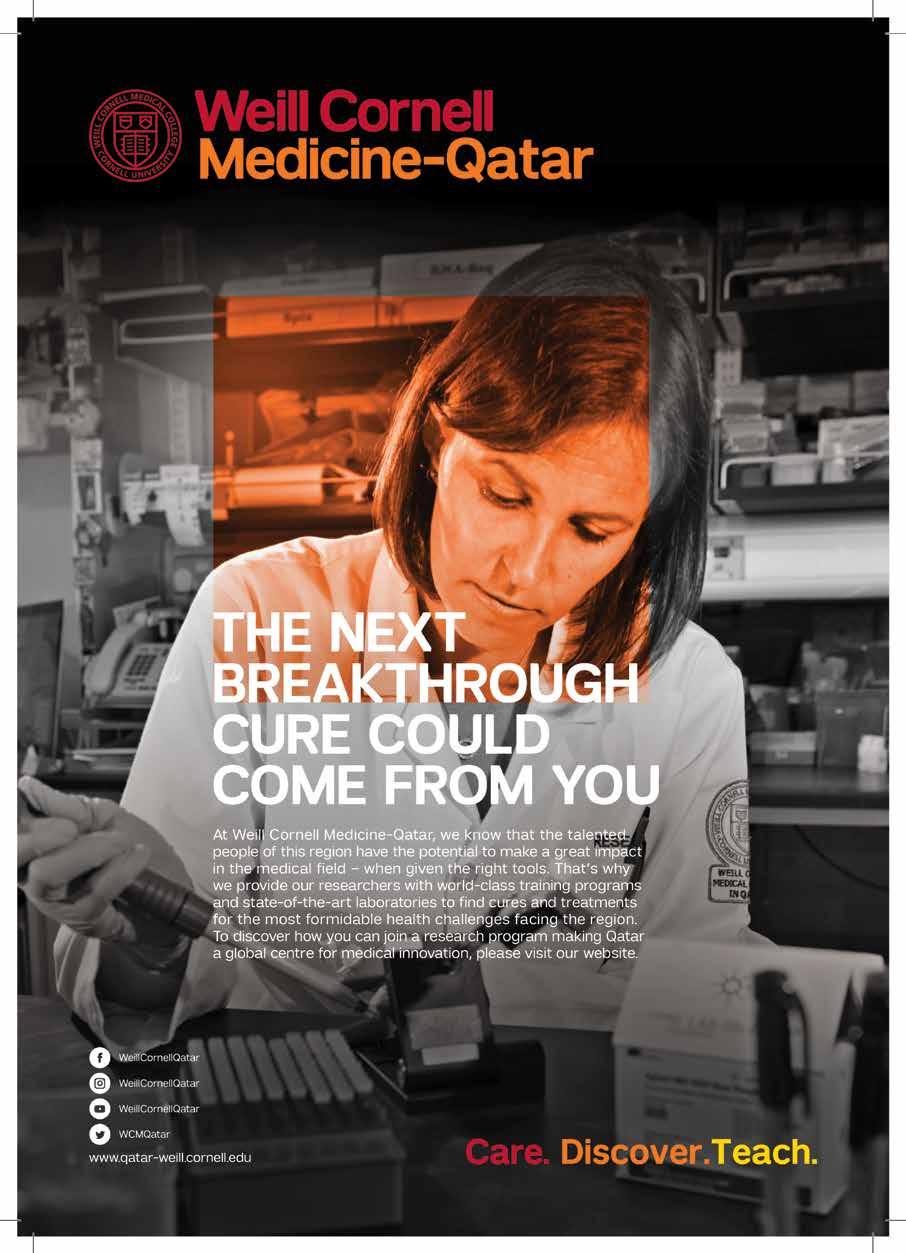
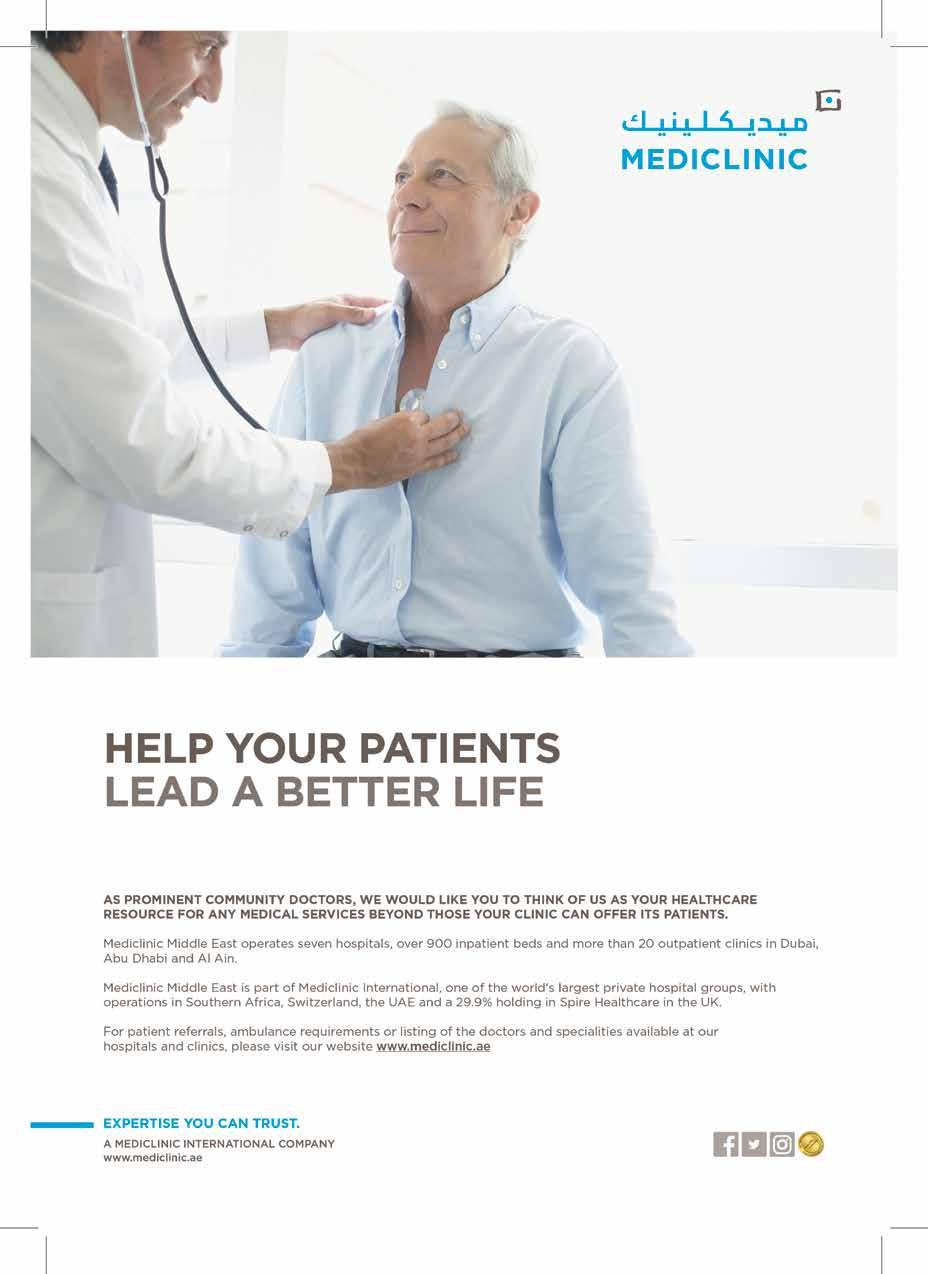

Prognosis
Women’s Health
There have been many developments in women’s health in recent years. Some notable ones include: Advances in breast cancer screening which has improved the detection and treatment of breast cancer in its early stages, reducing the need for invasive treatments and leading to increased survival rates.
The development of the human papillomavirus vaccine has greatly reduced the incidence of cervical cancer, as well as other types of cancer caused by the virus.
With the advent of personalized medicine, healthcare providers are able to tailor treatments to an individual’s unique genetic makeup. This has been particularly beneficial in women’s health, as certain genetic mutations can increase the risk of breast and ovarian cancer. By identifying these mutations, healthcare providers can develop targeted prevention and treatment plans.
Women are more likely than men to experience mental health issues such as depression and anxiety. There is now a greater focus on mental health awareness and destigmatization, leading to increased access to mental healthcare services.
Over the past several years access to reproductive healthcare has improved. This has been particularly important for marginalized communities, who may face barriers to accessing these services.
In this issue we look at a recently published study that suggests that inducing labour at the 39th week of pregnancy for people having their first births with a single baby that is low risk, doesn’t necessarily reduce the risk of caesarean births. In fact, the researchers say, for some birthing individuals, it may even have the opposite effect if hospitals don’t take a thoughtful approach to induction policies.
We also look briefly at a study which suggests that women with obesity may share risk for the disease with their daughters, but not their sons.
In another study covered in this issue, scientists from Brigham and Women’s Hospital show that a woman’s emotional wellbeing may be associated with their gut health.
You can read more about these studies and other newly published research in this issue of Middle East Health.
Callan Emery Editor editor@MiddleEastHealth.com
Publisher Michael Hurst Michael@MiddleEastHealth.com
Editor Callan Emery editor@MiddleEastHealth.com
Editorial Consultants
Dr Gamal Hammad, Dr Peter Moore, Harry Brewer
Middle East Editorial Office PO Box 72280, Dubai, UAE
Telephone: (+9714) 391 4775 editor@MiddleEastHealth.com
Marketing Manager

Foehn Sarkar
Telephone: (+9714) 391 4775 n Fax: (+9714) 391 4888 marketing@MiddleEastHealth.com
Subscription & Admin Manager
Savita Kapoor
Telephone: (+9714) 391 4775 n Fax: (+9714) 391 4888 Savita@MiddleEastHealth.com
Advertising Sales PO Box 72280, Dubai, UAE marketing@MiddleEastHealth.com
Americas, France Joy Sarkar P O Box 72280, Building No.2
2nd Floor, Dubai Media City
Dubai, United Arab Emirates
Tel: +971 4 391 4775 Fax: +971 4 391 4888 Joy@MiddleEastHealth.com
Japan
Mr Katsuhiro Ishii
Ace Media Service Inc
12-6, 4-chome, Adachi-ku, Tokyo 121-0824, Japan
Tel: +81-3-5691-3335 n Fax:+81-3-5691-3336
Email: amskatsu@dream.com
China
Miss Li Ying Medic Time Development Ltd, Flat 1907, Tower A, Haisong Building, Tairan 9th Road, Futian District, Shenzhen, China 518048
Tel: +86-755-239 812 21 n Fax: +86-755-239 812 33 Email: medic8@medictime.com
Taiwan
Larry Wang
Olympia Global Co Ltd
7F, No.35, Sec 3, Shenyang Rd, Taichung
Taiwan 40651 n P O Box: 46-283 Taichung Taiwan 40799
Tel: +886- (4)-22429845 n Fax:+886- (4)-23587689
Email: media.news@msa.hinet.net
Middle East Health is published by Hurst Advertising FZ LLC , Dubai Media City, License Number: 30309

UAE National Media Council - Approval Number: 2294781
Middle East Health online www.MiddleEastHealth.com
Middle East Health is printed by Atlas Printing Press. www.atlasgroupme.com

MIDDLE EAST HEALTHI 3 May - June 2023 Serving the region for 40 years

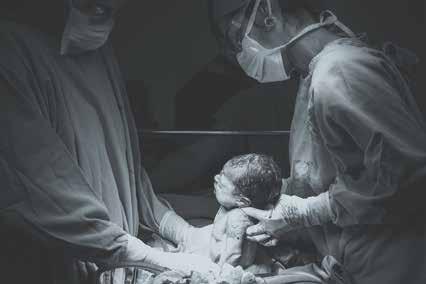
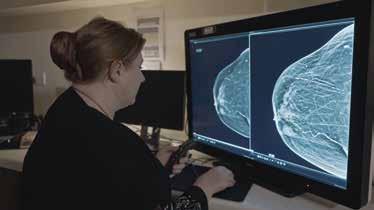


4 IMIDDLE EAST HEALTH contents NEWS 6 Middle East Monitor 10 Worldwide Monitor 14 The Laboratory FOCUS NEWS FEATURES THE BACK PAGE 20 Women’s Health: Healthcare providers urged to rethink treatment for female amputees 21 Women’s Health: New research finds labour induction doesn’t always reduce caesarean birth risk or improve outcomes for term pregnancies 22 Women’s Health: Emotional wellbeing may be linked to women’s gut health 23 Women’s Health: Obesity risk may pass from mothers to daughters 32 United States Report: The United States leads the way in global MedTech R&D 38 Surgery: Team performs first-of-its-kind, in-utero procedure to fix deadly vascular malformation 39 Surgery: Future trends in interdisciplinary neurointervention and skull base surgery 42 Hospital Design: Future-proofing global healthcare infrastructure 48 Evidence of conscious-like activity in the dying brain 34 24 28 6 21
30 Scientists release a new human “pangenome” reference
Patricia Prudente / Unsplash

middle east monitor
Update from around the region
UAE’s MBZUAI advances healthcare with new AI research collaborations
Following a series of recent healthcare indus try collaborations, the UAE’s Mohamed bin Zayed University of Artificial Intelligence (MBZUAI) – the world’s first graduate re search university focused only on AI – is shin ing a light on its unique mission to undertake significant research that seeks personalized solutions aimed at advancing society.
In March, MBZUAI and IBT joined forces in a five-year R&D agreement that will see the two parties form a joint re search lab to develop personalized digital therapeutics for human brain health by optimizing the power of AI technologies.
The collaboration looks to capitalize on IBT’s capacity in developing and commer cializing digital therapeutics alongside MB ZUAI expertise in AI, with the ultimate goal of realizing powerful, personalized brain and mental disorder treatments.
BioMap
Also in March, MBZUAI announced a memorandum of understanding (MoU) with BioMap, a disruptive super-scale AI life science platform, to establish a biocomputing research laboratory that will be a first-of-its-kind in the Middle East.

Under the terms of the MoU, the two parties have agreed to focus on creating breakthroughs in AI-generated proteins (AIGP) in line with the demands of the Middle East’s most pressing needs in medical health, drug design, and other critical
eration, protein structure prediction, cell function prediction, and other foundational life science challenges.

One such challenge is ageing-associated diseases. MBZUAI and BioMap have agreed to collaborate using large-scale AI models for multi-omics pre-training to accelerate the discovery of drug targets for ageing-associated diseases, enabling the development of personalized treatments.
Quris-AI
In January this year, MBZUAI reached an agreement with Quris-AI to develop a world-class bio-AI center in Abu Dhabi, a state-of-the-art facility to support the faster development of safer and more highly personalized medications tailored specifi-
prediction platform, ensures the safety and efficacy of new drugs by revolutionizing the drug development process, pioneering clinical trials on chips – testing thousands of novel drug candidates on hundreds of miniaturized “patients-on-a-chip”.
Currently, around 90 percent of clinical trials for new medications end in failure, say Quris-AI executives, but their proprietary “patients-on-a-chip” technology promises to reduce loss by predicting which drugs are most likely to work in humans. The Quris-AI system rapidly performs test interactions using predictive AI technologies that simulate genetically diverse patients, eliminating the need for animal testing and avoiding the risk and cost associated with failed clinical trials.
KFSH&RC records highest number of successful transplant procedures
Leading tertiary and quaternary healthcare provider, King Faisal Specialist Hospital & Research Centre (KFSH&RC) has broken new ground in the Middle East by surpassing top healthcare centres in performing the highest number of transplantations with a high graft success rate in 2022.
KFSH&RC’s team completed 537 bone marrow transplants, 32 CAR T-Cell transplants, and 1016 solid organ transplants to achieve the milestone. Among the procedures, KFSH&RC successfully performed a
heart transplant on a six-month-old Emirati baby, the youngest recipient in the Middle East.
Dr Yaseen Mallawi, Acting CEO of Health Care Delivery at KFSH&RC, commented: “The increasing demand for transplantation calls for agile medical practices and landscapes in different parts of the world to promote healthcare equity and access to timely care. In this light, KFSH&RC is committed to closing gaps in the international healthcare industry and providing the highest level
of specialized care and treatment with stateof-the-art infrastructure and accomplished medical experts. The newest achievement of our dedicated Organ Transplant Center of Excellence is a testament to this unwavering commitment.”
Established in October 2020
KFSH&RC’s Organ Transplant Center of Excellence offers comprehensive and advanced multi-organ transplantation, specializing in high-risk liver, kidney, pancreatic, and paediatric transplants.
6 IMIDDLE
EAST HEALTH


UAE residents are using technology to take control of their health, finds Philips survey
Royal Philips, a global leader in health technology, has released its first Health Trends Research United Arab Emirates (UAE) findings, shedding light on the state of local healthcare. Philips commissioned Censuswide, an independent market research consultancy, to conduct the study aimed to equip healthcare providers with insights into current health trends and public perceptions of healthcare in the UAE – enabling them to adapt to these shifts in demand to address immediate priorities and future needs.
“At Philips, we believe that the study validates that the UAE is well-positioned to transition its healthcare approach from sick care, which has historically been the norm, to value-based healthcare. This transformation begins with a greater emphasis on proactive preventive measures, supported by advanced technology that enables improved health outcomes at every stage of care, including diagnosis, treatment, and follow-up care,” said Marc Antoine Zora, General Manager and District Leader, Gulf & Levant, Philips Middle East.
Lucy Stewart, Head of Client Services, Censuswide, noted: “While residents perceive themselves to generally be in good health, they want to be more proactive, and are ready to embrace digital health technology to realize a healthier future, for themselves and our planet.”
Shift in consumer perceptions
The shifts in consumer perceptions and behavior towards well-being and technology, revealed in the Philips Health Trends Research UAE, are expected to have a long-term impact on the way people think about and engage with healthcare in the future.
Three key themes are particularly prominent in the findings: The pandemic has led to greater health consciousness among UAE residents, with 95% taking a proactive approach to protecting their health and 70% feeling more in control of their health since its onset. 89% of respondents rated their current health status as good, with an impressive 88% committing to being more proactive about their health and
well-being. Additionally, UAE residents are also aware of how different factors can impact their health, acknowledging that oral health can affect their general health (87%) and heart health (75%).
This drive for improved health is supported by the top four factors that make it easier for people to focus on their health: a better understanding of healthy living (53%), access to and maintenance of personal medical records (52%), mentor programmes that provide guided health support to keep them on track (48%) and doctors having access to their information regardless of a hospital (48%).
Embracing digital health tech
The pandemic has accelerated the adoption of digital technologies in the healthcare sector, increasing people’s trust in health technology.
The Philips Health Trends Research UAE reveals that 95% of respondents believe technology can help manage their health more efficiently due to its ease of use (51%), faster access to specialists and healthcare professionals (51%), easier access to results (50%), and by allowing all their healthcare data to be stored in one place (46%).
With most UAE residents believing in the benefits of digital health solutions, 67% of respondents confirmed that they are aware of telehealth. The research indicates that 90% would consider using telehealth solutions, and 72% believe virtual discussions with doctors are as effective as face-to-face examinations.
The data confirms that UAE residents are largely agreeable to providing access to their personal data for developmental purposes, with 38% open to allowing all their data to be used, 37% allowing most to be used, and 20% allowing a small portion to be used.
This creates considerable opportunity to truly transform healthcare by tapping into the latest innovations in telehealth that offer several advantages, including easy access to specialized healthcare professionals – regardless of their physical location, with increased opportunities to collaborate, cost savings for both patients and providers, more efficient care with shorter waiting times, and regular
and systematic touchpoints: all contributing to better patient outcomes.
Sustainability
The Philips Health Trends Research has also revealed that most UAE residents (82%) believe that sustainability should be a priority for healthcare companies. Respondents’ top considerations also highlighted the importance of prioritizing practices that do not harm the environment, with 51% of respondents indicating this as a key priority. Nearly half of the respondents (48%) believe that healthcare companies should conduct their business in a sustainable manner, while 41% feel that these companies should aim to become carbon negative.
These results indicate that residents in the UAE greatly value sustainable business practices; creating the heightened need for healthcare leaders to achieve sustainable healthcare.
“It is encouraging to see such a close alignment between the healthcare fraternity and UAE residents,” said Zora. “Many healthcare leaders are already turning to healthcare technologies to help them replace outdated, less efficient operations and technologies in favour of sustainability. With the patient population embracing sustainable innovations, we believe the sector has an unparalleled opportunity to expand access to quality healthcare, sustainably, while improving outcomes for better healthcare in the UAE and beyond.”
The Philips Health Trends Research
UAE was conducted online by Censuswide, an independent market research consultancy. There were 495 respondents in the UAE aged between 18-64 with quotas set to ensure that SEC groups and regions represented the country distribution. Gender quotas were also set to achieve a 50/50 split. The survey took place between May & June 2022.

8 IMIDDLE EAST HEALTH
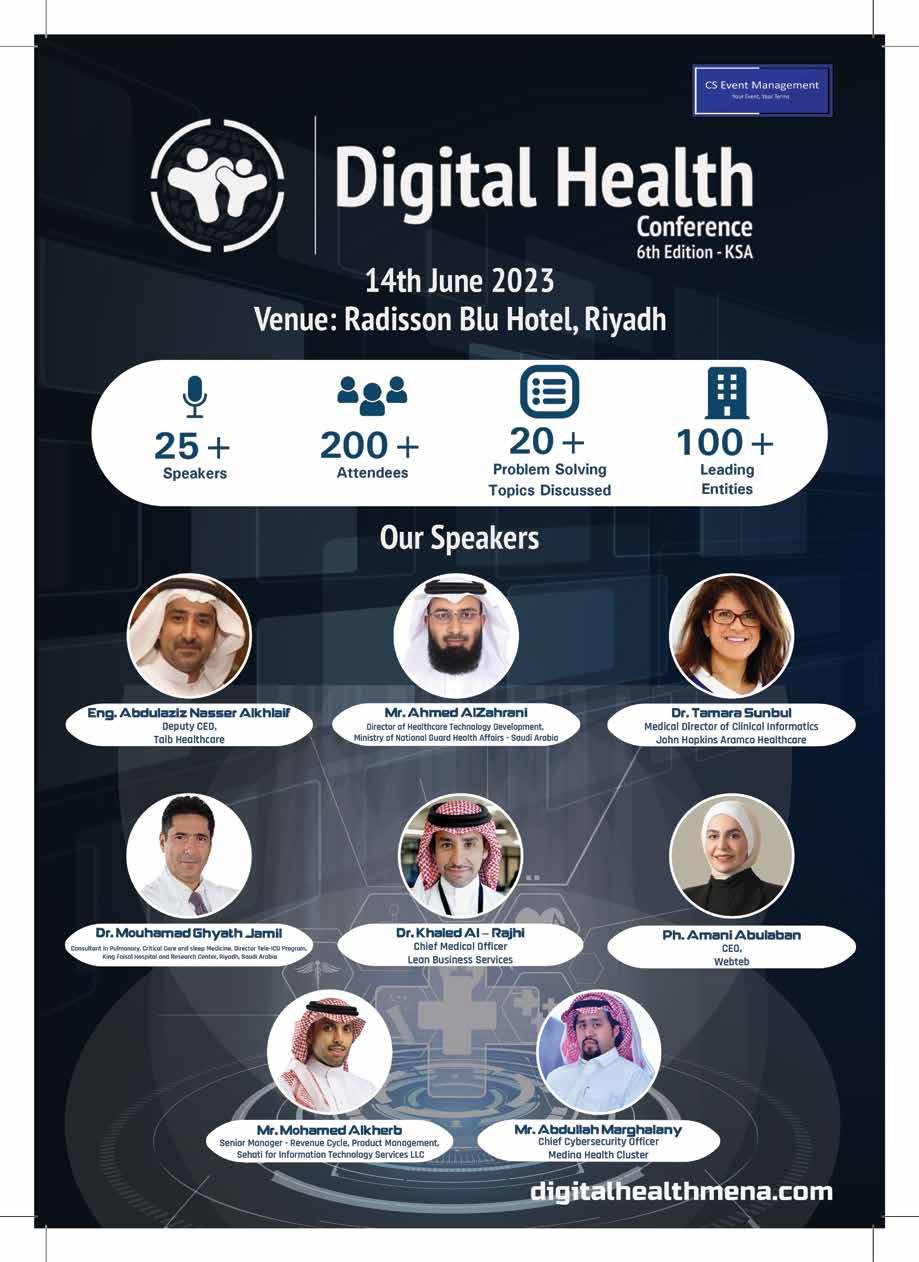
Proximie launches PxLens wearable ‘smart glasses’ for the OR in GCC
Proximie, a global health technology platform for digitising operating rooms, has launched PxLens in the GCC.
The PxLens is a lightweight, wearable ‘smart glasses’ device with embedded software. The head-mounted device allows surgeons to share a ‘first-person’ perspective of open surgeries and minimally invasive procedures. The PxLens’ seamless integration into Proximie’s cloud-based platform for telepresence, content management, and insights from the OR makes the device unique in the market.
The first-person perspective allows participants observing remotely to have a far clearer picture of the surgery – providing opportunities to advise where necessary and/or learn from cutting-edge surgical techniques. PxLens provides this insight and data without requiring stationery or

installed cameras in the OR, giving users more valuable data and insights with minimal equipment and creating scope to use the Proximie platform in a wider array of procedures.
The PxLens can be used by anyone, anywhere, within 15 minutes of unboxing when paired with the Proximie mobile app. Voice activated commands enable hands-free control, and robust battery packs that can be swapped mid-procedure ensure even the longest procedures can be fully streamed and recorded.
Dr Nadine Hachach-Haram, founder and CEO of Proximie, said: “Lightweight and easy-to-use, PxLens integrates seamlessly with the Proximie platform to provide a superior
perspective on surgery and is another exciting addition to our suite of telepresence, content management, and data insights solutions. It shows the positive impact wireless devices can have in creating borderless, seamless ORs.

“The PxLens is another step on Proximie’s journey to help surgeons deliver effective and efficient care. A solution that meets the demands of the advanced health landscape in the UAE and across the Middle East. It provides an insightful first-person perspective and helps make the recording and sharing of procedures ubiquitous. This improves patient care, training, skills development, and overall surgical efficiency.”
Mubadala Health signs MoU with Emirates Medical Association to advance medical education and research in UAE
Mubadala Health, the Abu Dhabi-based integrated network of healthcare facilities, and Emirates Medical Association (EMA), a non-profit organization that represents physicians and allied health professionals in the UAE, signed a Memorandum of Understanding (MoU) to collaborate and advance medical education and research opportunities in the UAE. The MoU signing is a significant milestone for both entities and contributes to the strengthening of the Abu Dhabi healthcare ecosystem.
As part of the MoU, Mubadala Health and EMA will collaborate on joint programmes, training centres, and educational materials. They will also join forces to advance medical education and research opportunities, with a particular emphasis on increasing the availability of continuous professional development programs across multiple specializations to elevate and progress national expertise and capabilities. The two organizations will also conduct research studies and clinical trials
to develop new healthcare options for a wide variety of medical conditions.
Hasan Jasem Al Nowais, Chief Executive Officer, Mubadala Health, said: “Mubadala Health is delighted to partner with Emirates Medical Association in an effort to advance healthcare education and research in the UAE. Through this collaboration, we aim to continue our work in advancing healthcare in the UAE and wider region, with a focus on continuous capacity development. We are confident that this collaboration will contribute to Mubadala Health’s mission to bringing world-class healthcare closer to home and by playing a critical role in increasing the availability of continuous professional development programmes across key medical specializations that are critical to the UAE’s healthcare offering.”
Dr. Mouza Abdulla Alsharhan, President, Emirates Medical Association, said: “We are pleased to partner with Mubadala Health to improve the healthcare in-
dustry in the UAE. Our aim is to play a vital role in the continuous improvement in the quality of healthcare in the UAE, by being an integral part of the professional life of every physician. We strive to keep our members up to date with the global changes and advancements in practice within the medical field. This partnership will bring value to our members and support our key objectives to improve healthcare in the region. We look forward to collaborating on joint programmes consisting of training centres, educational materials, and certification for the proceeding education and professional growth programmes.”
As part of the MoU, EMA will support the enrolment of Mubadala Health physicians under medical societies and clubs affiliated with the association. Moreover, Mubadala Health will assign key opinion leaders from their institutions to work with EMA societies to overview the works on agreed fields of collaboration.
10 IMIDDLE EAST HEALTH

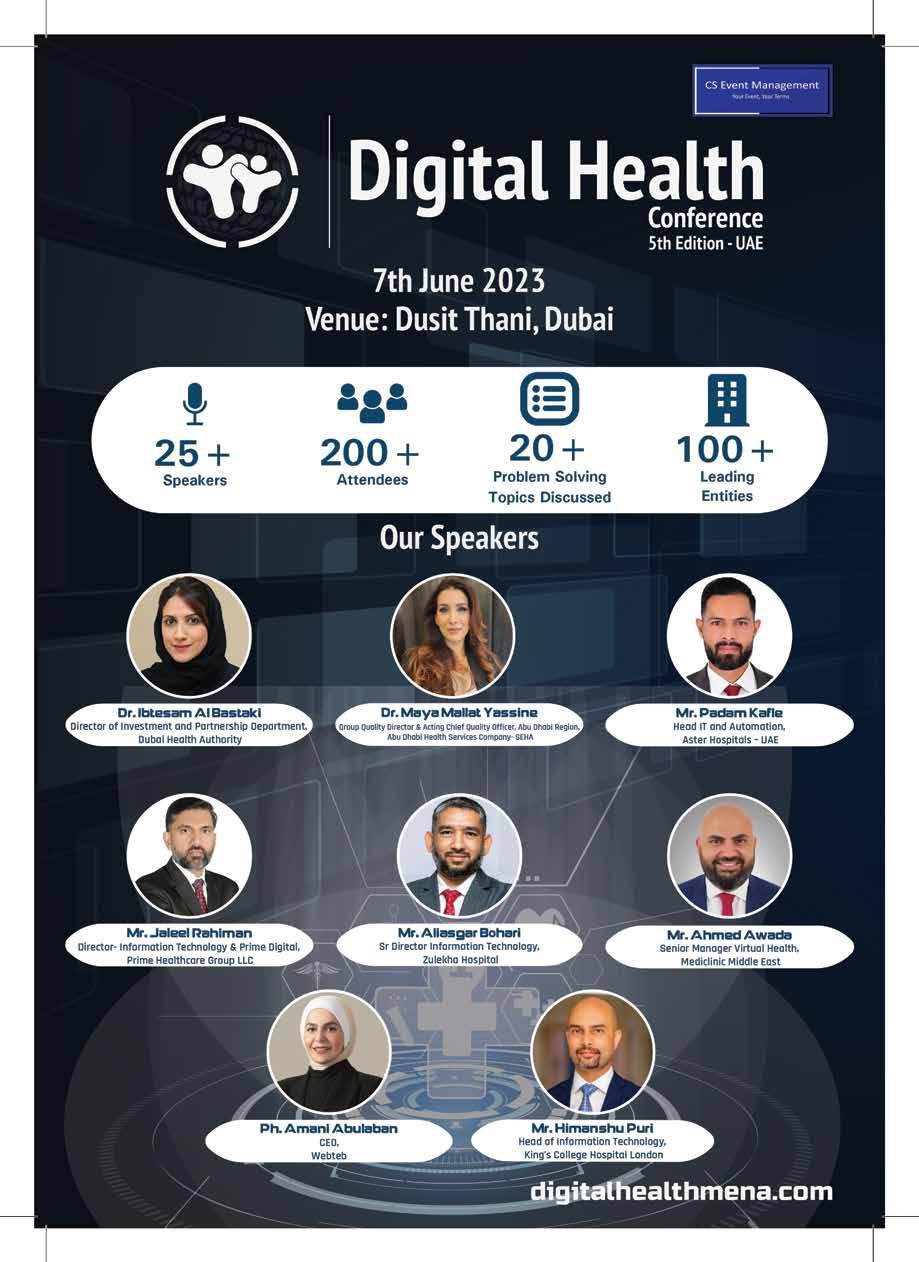
worldwide monitor Update from around the globe
Armis identifies riskiest medical and IoT devices in clinical environments
Armis, a leading asset visibility and security company, has released new research identifying the top connected medical and IoT devices that are exposed to malicious activity in clinical environments. Data analyzed from the Armis Asset Intelligence and Security Platform < https://www.armis.com/ platform >, which tracks over three billion assets, found nurse call systems to be the riskiest* IoMT device, followed by infusion pumps and medication dispensing systems. When looking at IoT devices, IP cameras, printers and Voice Over Internet Protocol (VoIP) devices top the list.
By 2026, smart hospitals are expected to deploy over 7 million IoMT devices, doubling the amount from 2021. Medical and nonmedical devices are increasingly connected, automatically feeding patient data from monitoring devices into electronic records. These connections and communications within a medical environment help improve patient care but also make it increasingly vulnerable to cyberattacks, which could result in the interruption of patient care.
Upon a comprehensive analysis of the data from all connected medical and IoT devices on the Armis Asset Intelligence and Security Platform, several noteworthy conclusions can be drawn:
• Nurse call systems are the riskiest connected medical device, with 39% of them having critical severity unpatched Common Vulnerabilities and Exposures (CVEs) and almost half (48%) having unpatched CVEs.
• Infusion pumps are second, with 27% having critical severity unpatched CVEs and 30% having unpatched CVEs.
• Medication dispensing systems are in third place, with 4% having critical severity unpatched CVEs, but 86% having unpatched CVEs. Moreover, 32% run on unsupported Windows versions.
• Almost 1 in 5 (19%) connected medical devices are running unsupported OS versions.
• More than half of IP cameras we monitored in clinical environments have critical severity unpatched CVEs (56%) and unpatched CVEs (59%), making it the riskiest IoT device.
• Printers are the second riskiest IoT

device in clinical environments, with 37% having unpatched CVEs, and 30% having critical severity unpatched CVEs.
• VoIP devices are in third place. Although 53% of them have unpatched CVEs, only 2% have critical severity unpatched CVEs.
“These numbers are a strong indicator of the challenges faced by healthcare organizations globally. Advances in technology are essential to improve the speed and quality of care delivery as the industry is challenged with a shortage of care providers, but with increasingly connected care comes a bigger attack surface,” said Mohammad Waqas, Principal Solutions Architect for Healthcare at Armis. “Protecting every type of connected device, medical, IoT, even the building management systems, with full visibility and continuous contextualized monitoring is a key element to ensuring patient safety.”
WHO introduces new initiative to improve pandemic preparedness
To help countries better prepare for future pandemics, WHO launched a new initiative that provides guidance on integrated planning for responding to any respiratory pathogen such as influenza or coronaviruses.
The new Preparedness and Resilience for Emerging Threats Initiative < https://www.who.int/initiatives/ preparedness-and-resilience-for-emergingthreats >, or PRET, incorporates the latest tools and approaches for shared
learning and collective action established during the COVID-19 pandemic and other recent public health emergencies.
Through the initiative, WHO will use a mode of transmission approach to guide countries in pandemic planning, given that many capacities and capabilities are common among groups of pathogens. PRET answers the call for technical guidance and support for promoting and strengthening integrated preparedness and response, as outlined in World Health As-
sembly resolutions.
The COVID-19 pandemic and other health emergencies have shown that countries need to be operationally ready to respond to infectious disease threats, with tailored preparedness plans in hand and better coordination and collaboration with other sectors such as agriculture.
“Preparedness, prevention, and response activities must not be the province of the health sector alone,” said Dr Tedros Adhanom Ghebreyesus, WHO Director-General.
12 IMIDDLE EAST HEALTH
WHO releases the largest global collection of health inequality data
WHO is launching the Health Inequality Data Repository, the most comprehensive global collection of publicly available disaggregated data and evidence on population health and its determinants. The repository allows for tracking health inequalities across population groups and over time, by breaking down data according to group characteristics, ranging from education level to ethnicity.
The data from the repository show that, in just a decade, the rich-poor gap in health service coverage among women, newborns and children in low- and middle-income countries has nearly halved. They also reveal that, in these countries, eliminating wealth-related inequality in under-five mortality could help save the lives of 1.8 million children.
The Health Inequality Data Repository (HIDR) includes nearly 11 million data points and consists of 59 datasets from over 15 sources. The data include measurements of over 2000 indicators broken down by 22 dimensions of inequality, including demographic, socioeconomic and geographical factors. Topics covered include: the Sustainable Development Goals (SDGs); COVID-19; reproductive, maternal and child health; immunization; HIV; tuberculosis; malaria; nutrition; health care; non-communicable diseases and environmental health.
“The ability to direct services to those
“Just as health emergencies have impacts across many sectors, so must our preparedness and response efforts span sectors, disciplines and pathogens. It is critical, too, that community engagement and equity are the centre of our efforts, especially for those populations that are marginalized and most at risk.”
PRET is an evolution in WHO’s approach to pandemic preparedness through the application of a mode of transmission lens, rather than a focus on specific diseases. WHO will continue to develop and disseminate guidance on specific diseases as needed.
The PRET Initiative’s first module fo-
who need them the most is vital to advancing health equity and improving lives. Designed as a one-stop-shop for data on health inequality, the Repository will help us move beyond only counting births and deaths, to disaggregating health data according to sex, age, education, region and more,” said Dr Tedros Adhanom Ghebreyesus, WHO DirectorGeneral. “If we are truly committed to leaving no one behind, we must figure out who is being missed.”
However, disaggregated data are still not available for many health indicators, and where they are available, they are most frequently broken down only by sex and, to a lesser extent, by age and place of residence. For instance, only 170 of the 320 indicators in WHO’s gateway for health-related statistics, the Global Health Observatory < https://www.who. int/data/gho > , are disaggregated, of which 116, or two thirds, are disaggregated only by sex.
Though limited, the available disaggregated data reveal important inequality patterns. In high-income countries, hypertension is more common among men than women and obesity rates are similar among men and women. By contrast, in lowincome countries, hypertension rates are similar among women and men, but obesity
cuses on respiratory pathogens, including influenza, coronaviruses, and respiratory syncytial virus. Given the ongoing COVID-19 pandemic and the possible threat of avian influenza, this module will enable countries to critically review, test, and update their respiratory pandemic planning efforts to ensure they have the functional capacities and capabilities in place.
A process is underway to identify the next group of pathogens, such as arboviruses, to be addressed under this initiative. This will follow priorities identified through the ten proposals to strengthen
rates are higher among women than men.
The repository also reveals inequalities in national COVID-19 responses. In 2021, in more than a third of the 90 countries with data, COVID-19 vaccination coverage among the most educated was at least 15 percentage points higher than among the least educated.
Releasing the HIDR, WHO is calling on countries to adopt routine health inequality monitoring, make disaggregated data publicly available, expand data collection and increase capacity for analysis and reporting. Inequality analyses should be conducted regularly at the global, national and subnational levels, with health inequality monitoring integrated into global and national goals, indicators and targets, and health performance assessments. WHO is committed to working with countries and partners to update and expand this resource annually.
• All the datasets of the HIDR < https:// www.who.int/data/inequality-monitor/data > can be explored using the Health Equity Assessment Toolkit (HEAT) < https://www. who.int/data/inequality-monitor/assessment_ toolkit > software and downloaded through the Health Inequality Monitor website < https://www.who.int/data/inequality-monitor >, as well as via an Application Programming Interface (API).
the global architecture for health emergency preparedness, response, and resilience (HEPR).
The PRET Initiative ushers in a new era for pandemic preparedness and represents an evolution of WHO’s core activities to support all Member States in strengthening health emergency preparedness, prevention, and response capacities and capabilities. The initiative can also serve to operationalize the objectives and provisions of the Pandemic Accord, which is currently being negotiated by WHO Member States.
MIDDLE EAST HEALTHI 13
the laboratory
Medical research news from around the world
Novel ablation strategy improves freedom from arrhythmias in atrial fibrillation patients
An innovative three-step ablation approach including ethanol infusion of the vein of Marshall improves freedom from arrhythmias in patients with persistent atrial fibrillation compared to pulmonary vein isolation (PVI) alone, according to science presented at EHRA 2023, the annual congress of the European Heart Rhythm Association (EHRA) – a branch of the European Society of Cardiology (ESC). Preliminary results at 10 months are presented, with follow up ongoing until 12 months.
The cornerstone of catheter ablation of atrial fibrillation is complete isolation of the pulmonary veins [1]. However, only 50–60% of patients remain in sinus rhythm at two years [2]. Numerous trials of different ablation strategies have failed to demonstrate superiority over PVI [2]
The Marshall-Plan ablation strategy consists of 1) PVI; 2) ethanol infusion of the vein of Marshall; and 3) a linear ablation set to block the three main anatomical isthmuses to the pulmonary veins (dome, mitral and cavotricuspid isthmus lines). The technique focuses on anatomical targets that have been individually recognised as important for the initiation or maintenance of atrial fibrillation but have not been collectively targeted in a systematic manner. The current investigators previously reported encouraging results using this strategy in non-randomised studies [3, 4] .
The present study compared 12-month arrhythmia-free survival with the MarshallPlan ablation strategy versus PVI only. This was a prospective, randomised, parallel group trial of superiority. The trial included 120 patients with symptomatic persistent atrial fibrillation for more than one month. The average age of participants was 67 years and 21 (18%) were women.
Participants were randomised to receive the Marshall-Plan or PVI alone. Follow up occurred at 3, 6, 9 and 12 months during which patients underwent a number of tests including an electrocardiogram (ECG), echocardiography, stress test and 24-hour Holter monitoring. Recurrence

of arrhythmias was identified using ECG teletransmission, with findings sent to the hospital once a week plus any time the patient had symptoms. The primary endpoint was recurrence of atrial fibrillation or atrial tachycardia lasting more than 30 seconds at 12 months (including a 3-month blanking period) after a single ablation procedure.
The total radiofrequency time was significantly longer in the PVI group (29 minutes) compared with the MarshallPlan group (23 minutes; p<0.001). The full lesion set was successfully completed in 53 patients (88%) receiving the MarshallPlan strategy and 59 patients (98%) receiving PVI only. In an intention-to-treat analysis, the recurrence of arrhythmias after an average follow up of 10 months was significantly higher in the PVI group compared with the Marshall-Plan group (18 vs. 8 patients; p=0.026). Follow up will continue until 12 months.
Principal investigator Dr Nicolas Derval of the University Hospital of Bordeaux, France said: “After 10 months of follow up, the success rate in the Marshall-Plan group was significantly better (87%) compared to the PVI only group (70%). However, the results are still preliminary as follow up is
not completed for all patients. While the findings indicate that the Marshall-Plan strategy holds promise for patients with persistent atrial fibrillation, they need to be confirmed in a multicentre trial.”
References
1. Hindricks G, Potpara T, Dagres N, et al. 2020 ESC Guidelines for the diagnosis and management of atrial fibrillation developed in collaboration with the European Association of Cardio-Thoracic Surgery (EACTS). Eur Heart J. 2021;42:373–498.
2. Verma A, Jiang CY, Betts TR, et al. Approaches to catheter ablation for persistent atrial fibrillation. N Engl J Med. 2015;372:1812–1822.
3. Pambrun T, Denis A, Duchateau J, et al. MARSHALL bundles elimination, Pulmonary veins isolation and Lines completion for ANatomical ablation of persistent atrial fibrillation: MARSHALL-PLAN case series. J Cardiovasc Electrophysiol. 2019;30:7–15.
4. Derval N, Duchateau J, Denis A, et al. Marshall bundle elimination, Pulmonary vein isolation, and Line completion for ANatomical ablation of persistent atrial fibrillation (Marshall-PLAN): Prospective, single-center study. Heart Rhythm. 2021;18:529–537.
14 IMIDDLE EAST HEALTH
New score predicts heart failure improvement after atrial fibrillation ablation
A score based on four readily available clinical and imaging parameters identifies the heart failure patients who benefit most from atrial fibrillation ablation, according to science presented at EHRA 2023, Atrial fibrillation and heart failure often coexist [1]. It is estimated that approximately 30% of patients with heart failure will develop atrial fibrillation and patients with atrial fibrillation have a five-fold increased risk of developing heart failure [2]. Each condition aggravates the prognosis of the other. Atrial fibrillation patients who develop heart failure have a three-fold increased risk of death, while in heart failure patients, the risk of death is two-fold higher when atrial fibrillation is also present.
Medium-sized randomised trials have produced mixed evidence on the benefit of ablation in patients with heart failure, with outcomes largely depending on the selection and characteristics of patients. Therefore, there is uncertainty about which heart failure patients should be referred for ablation. ESC Guidelines on atrial fibrillation recommend the procedure to reverse left ventricular dysfunction in atrial fibrillation patients when tachycardia-induced cardiomyopathy is highly probable. In addition, catheter ablation should be considered in selected atrial fibrillation patients with heart failure and reduced ejection fraction to improve survival and reduce heart failure hospitalisation [1] .
“The tools to help clinicians determine who exactly these selected patients are and which patients have tachycardia-mediated cardiomyopathy are elusive and often subjective,” said principal investigator Dr Marco Bergonti of the Cardiocentro Ticino Institute - EOC, Lugano, Switzerland and a PhD student at the University of Antwerp, Belgium. “Further evidence is needed to help stratify and identify those patients who will most likely benefit from atrial fibrillation ablation. The Antwerp score was developed to predict the response to ablation in
heart failure patients with impaired (below 50%) ejection fraction.”
The score is based on four parameters: QRS width above 120 milliseconds (2 points), known aetiology (2 points), paroxysmal atrial fibrillation (1 point) and severe atrial dilation (1 point). Total scores range from 0 to 6, with 0 indicating a greater likelihood of recovery. A previous single-centre study by the ANTWOORD investigators showed that the ANTWERP score estimated the probability of left ventricular ejection fraction (LVEF) recovery after ablation of atrial fibrillation [3]
The current ANTWOORD study aimed to externally validate the ANTWERP score in a large European multicentre cohort. The researchers retrospectively identified patients with heart failure, impaired LVEF and atrial fibrillation who had an ablation procedure at eight centres in Europe. Participants underwent echocardiography to assess LVEF before ablation and 12 months afterwards. The primary endpoint was sufficient improvement in ejection fraction at the 12-month echocardiography to be considered a “Responder” to treatment. Responders were defined according to the 2021 universal definition of heart failure:
1) in patients with a baseline LVEF of 40–50%, an LVEF increase to 50% or more;
2) in those with a baseline LVEF of 40% or below, an increase in LVEF of at least 10% from baseline, and a second measurement of LVEF above 40% [4]
The study included 605 patients. The average age was 61 years and 24% were women. Some 427 patients (70%) were classified as responders and were more likely to have positive ventricular remodelling (odds ratio [OR] 8.9, p<0.001), fewer heart failure hospitalisations (OR 0.09, p<0.001) and lower mortality (OR 0.11, p<0.001) compared to non-responders. The Antwerp score predicted LVEF improvement after ablation with an area under the curve of 0.86 (95% confidence interval 0.82–0.89; p<0.001). For total scores of 0, 1, 2, 3, 4, and 5-6, the proportion of responders was 94%, 92%, 82%, 51%, 40% and 17%, respectively.
Dr Bergonti said: “Based on our findings,
patients with a low score (2 or less) may benefit from early referral for catheter ablation, with a more than 90% chance of recovery. Patients with a high score (5 or higher) have a very low expected recovery rate (below 20%) and hence may benefit more from alternative strategies such as aggressive rate control. Those in the intermediate zone (score 3-4, expected recovery rate 47%) may benefit from further diagnostic tests such as cardiac magnetic resonance to improve their diagnostic assessment, as the presence of late gadolinium enhancement has been associated with less LVEF improvement.”
References
1. Hindricks G, Potpara T, Nikolaos Dagres N, et al. 2020 ESC Guidelines for the diagnosis and management of atrial fibrillation developed in collaboration with the European Association of Cardio-Thoracic Surgery (EACTS). Eur Heart J. 2021;42:373–498.
2. Gopinathannair R., Chen LY., Chung MK., et al. Managing atrial fibrillation in patients with heart failure and reduced ejection fraction: a scientific statement from the American Heart Association. Circ Arrhythmia Electrophysiol. 2021;14:e000078.
3. Bergonti M, Spera F, Tijskens M, et al. A new prediction model for left ventricular systolic function recovery after catheter ablation of atrial fibrillation in patients with heart failure: The ANTWOORD Study. Int J Cardiol. 2022;358:45–50.
4. Bozkurt B, Coats AJS, Tsutsui H, et al. Universal definition and classification of heart failure: a report of the Heart Failure Society of America, Heart Failure Association of the European Society of Cardiology, Japanese Heart Failure Society and Writing Committee of the Universal Definition of Heart Failure: Endorsed by the Canadian Heart Failure Society, Heart Failure Association of India, Cardiac Society of Australia and New Zealand, and Chinese Heart Failure Association. Eur J Heart Fail. 2021;23:352–380.
New tracer differentiates fibrosis and inflammation in intestine of patients with Chrohn’s
Patients suffering from Crohn’s disease, a chronic inflammatory intestinal disorder, develop painful constrictions in the bowel. Due to a lack of methods until now, these complications cannot be characterised with sufficient precision to initiate targeted treatment. An interdisciplinary research group at MedUni Vienna has investigated a new imaging technique that can improve the treatment of intestinal strictures. The results of the study were recently published in the journal Radiology [1] .
Intestinal strictures are a common problem in patients with Crohn’s disease, a chronic inflammatory bowel disease. These strictures lead to cramping pain and digestive problems and therefore practically always require treatment. While purely inflammatory strictures respond very well to drug therapies, fibrotic narrowing, i.e. those associated with irreversible tissue changes, require surgical intervention. However, combinations of inflammation and fibrosis are often present in varying degrees. Up to now, there is no imaging
procedure which allows a therapy-relevant differentiation of inflammation of the intestinal wall and fibrosis.
In the search for precise imaging methods, a novel nuclear medicine tracer was used for the first time as part of MedUni Vienna’s interdisciplinary research work at the University Department of Radiology and Nuclear Medicine. This so-called FAPI tracer binds specifically to the fibroblast activating protein (FAP) of the connective tissue cells that lead to fibrosis in the diseased intestinal wall. Using the new tracer, a very good correlation of molecular imaging with the pathological extent of fibrosis could be demonstrated with PET-MRI. Even the differentiation between moderate and severe intestinal wall fibrosis became possible, which plays a role in the therapy decision.
“In future, the molecular imaging we have developed could be used to identify those patients who would benefit from surgical intervention at an early stage, thereby sparing them the need for less effective drug therapy for fibroid-stenosis,” said co-study leader
Michael Bergmann from the Department of Visceral Surgery at MedUni Vienna’s Department of General Surgery, summarising the great potential of these research findings. The study, led by the Department of Radiology and Nuclear Medicine, also involved scientists from the Clinical Institute of Pathology and the Department of Gastroenterology and Hepatology at the Department of Internal Medicine III. Follow-up studies are now planned in which the new method will be applied on a larger scale.
“In this context, we shall examine the course of patients with fibroid-stenosis and possible reversibility under new drug therapies,” said first author Martina Scharitzer (Department of Radiology and Nuclear Medicine).
Reference:
1. M. Scharitzer, A. Macher-Beer, T. Mang, et. al., Evaluation of Intestinal Fibrosis with 68Ga-FAPI PET/MR Enterography in Crohn Disease. Radiology, Feb 28 2023. doi: https://doi.org/10.1148/radiol.222389
New research has debunked the idea that there is an “obesity paradox”, whereby patients with heart failure who are overweight or obese are thought to be less likely to end up in hospital or die than people of normal weight.
The study, which is published in the European Heart Journal [1] 22 March 2023, shows that if doctors measure the ratio of waist to height of their patients, rather than looking at their body mass index (BMI), the supposed survival advantage for people with a BMI of 25kg/m2 or more disappears.
The “obesity paradox” relates to counter-intuitive findings suggesting that, although people are at greater risk of developing heart problems if they are overweight or obese, once a person has developed a heart condition, those with higher BMIs appeared to do better and were less likely to die than those of normal weight. Various explanations have been suggested,
including the fact that once someone has developed heart problems, some extra fat is somehow protective against further health problems and death, especially as people who develop a severe and chronic illness often lose weight.
John McMurray, Professor of Medical Cardiology at the University of Glasgow, who led the latest research, said: “It has been suggested that living with obesity is a good thing for patients with heart failure and reduced ejection fraction – which is when the main chamber of the heart is unable to squeeze out the normal amounts of blood. We knew this could not be correct and that obesity must be bad rather than good. We reckoned that part of the problem was that BMI was a weak indicator of how much fatty tissue a patient has.”
As Professor Stephan von Haehling, Consultant Cardiologist, and Dr Ryosuke Sato, a research fellow, both at the Univer-
sity of Göttingen Medical Center (Germany), write in an accompanying editorial[2], BMI fails to take account of the body’s composition of fat, muscle and bone, or where the fat is distributed. “Would it be feasible to assume that an American professional wrestler (more muscle) and a Japanese sumo wrestler (more fat) with the same BMI would have a similar risk of cardiovascular disease? The same is true for persons such as Arnold Schwarzenegger in his younger years when he starred as the ‘Terminator’ with a BMI of ~30 kg/m2.”
The study is the first to look at different ways of measuring the size and proportions of patients, including BMI, but also anthropometric measurements such as waist-to-height ratio, waist circumference and waist-to-hip ratio, and adjusting the patient outcomes to take account of other factors that play a role in, or predict, these outcomes, such as levels of natriuretic peptides – hormones that are
16 IMIDDLE EAST HEALTH
Study shows ‘obesity paradox’ does not exist: waist-to-height ratio is a better indicator of outcomes in patients with heart failure than BMI
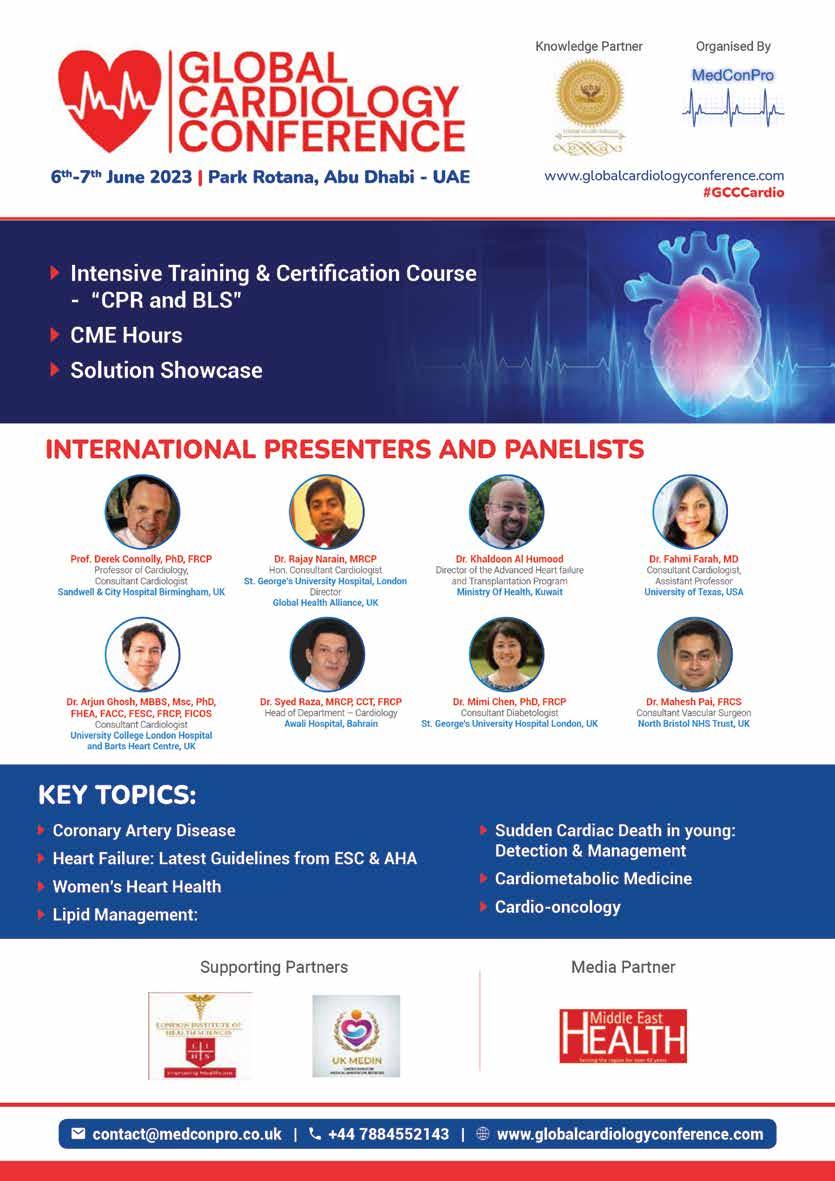
secreted in the blood when the heart is under pressure, as with heart failure.
“Natriuretic peptides are the single most important prognostic variable in patients with heart failure. Normally, levels of natriuretic peptides rise in people with heart failure, but patients living with obesity have lower levels than those who are normal weight,” said Prof. McMurray.
Prof. McMurray and colleagues analysed data from 1832 women and 6567 men with heart failure and reduced ejection fraction who were enrolled in the PARADIGMHF international randomised controlled trial taking place in 47 countries on six continents [3]. When the patients were randomised, doctors collected data on BMI, blood pressure, anthropometric measurements, results from blood tests, medical histories and treatments. The researchers were interested in which patients were hospitalised with heart failure or who died from it.
Obesity-survival paradox
An “obesity-survival paradox” showed lower death rates for people with BMIs of 25 kg/m2 or more [4], but this was eliminated when the researchers adjusted the results to take account of all the factors that can affect outcomes, including levels of natriuretic peptides.
First author of the study, Dr Jawad Butt, a research fellow from Copenhagen University Hospital—Rigshospitalet, Copenhagen (Denmark), who carried out the analyses, said: ” The paradox was far less evident when we looked at waist-to-height ratios, and it disappeared after adjustment for prognostic variables. After adjustment, both BMI and waist-to-height ratio showed that more body fat was associated with a greater risk of death or hospitalisation for heart failure, but this was more evident for waist-to-height ratio. When looking at waist-to-height ratio, we found the top 20% of people with the most fat had a 39% increased risk of being hospitalised for heart failure compared to people in the bottom 20% who had the least fat.”
Prof. McMurray said: “Our study shows there is no ‘obesity survival paradox’ when we use better ways of measuring body fat. BMI
does not take into account the location of fat in the body or its amount relative to muscle or the weight of the skeleton, which may differ according to sex, age and race. In heart failure specifically, retained fluid also contributes to body weight. It is indices that do not include weight, such as waist-to-height ratio, that have clarified the true relationship between body fat and patient outcomes in our study, showing that greater adiposity is actually associated with worse not better outcomes, including high rates of hospitalisation and worse health-related quality of life.
“Obesity is not good and is bad in patients with heart failure and reduced ejection fraction. These observations raise the question as to whether weight loss might improve outcomes, and we need trials to test this. In the UK, the National Institute for Health and Care Excellence, NICE, now recommends that waist-to-height ratio instead of BMI is used for the general population, and we should support this for patients with heart failure too.
“It is important because the underdiagnosis of heart failure in people living with obesity is a major issue in primary care. Patients’ symptoms of breathlessness are often dismissed as due solely to obesity. Obesity is a risk factor and driver of heart failure. Whereas in the past weight loss may have been a concern for patients with heart failure and reduced ejection fraction, today it is obesity.”
Prof. von Haehling and Dr Sato write in their editorial: “The present findings raise
References:
It is important because the underdiagnosis of heart failure in people living with obesity is a major issue in primary care. Patients’ symptoms of breathlessness are often dismissed as due solely to obesity. Obesity is a risk factor and driver of heart failure. Whereas in the past weight loss may have been a concern for patients with heart failure and reduced ejection fraction, today it is obesity.
the alarm over the term ‘obesity paradox’, which has been claimed to be based on BMI. Can we tell obese HF [heart failure] patients just to stay as they are? To adequately address this question, not only should the obesity paradox be revisited even in patients with HF with preserved ejection fraction (HFpEF) and in lean HF patients by WHtR [waist-to-height ratio], which better reflects pathophysiological processes of obesity, but also further tests are warranted to validate the effect of weight loss in ‘truly’ obese HF patients with a high WHtR.”
1. “Anthropometric measures and adverse outcomes in heart failure with reduced ejection fraction: revisiting the obesity paradox”, by Jaward H. Butt et al. European Heart Journal. doi: https://doi.org/10.1093/eurheartj/ehad083
2. “Revisiting the obesity paradox in heart failure: what is the best anthropometric index to gauge obesity?” by Ryosuke Sato and Stephan von Haehling. European Heart Journal. doi: https://doi.org/10.1093/eurheartj/ehad079
3. PARADIGM-HF (Prospective comparison of ARNI with ACEI to Determine Impact on Global Mortality and Morbidity in Heart Failure) was a randomised, doubleblind, placebo-controlled trial in patients with chronic heart failure with reduced ejection fraction (HFrEF), evaluating the efficacy and safety of angiotensin receptorneprilysin inhibitor saubitril/valsartan compared with enalaparil, added to standard care.
4. The study used the World Health Organization BMI categories: <18.5 kg/m2 is underweight, 18.5-24.9 kg/m2 is normal weight, 25-29.9 kg/m2 is overweight, and 30 kg/m2 upwards is obese.
18 IMIDDLE EAST HEALTH
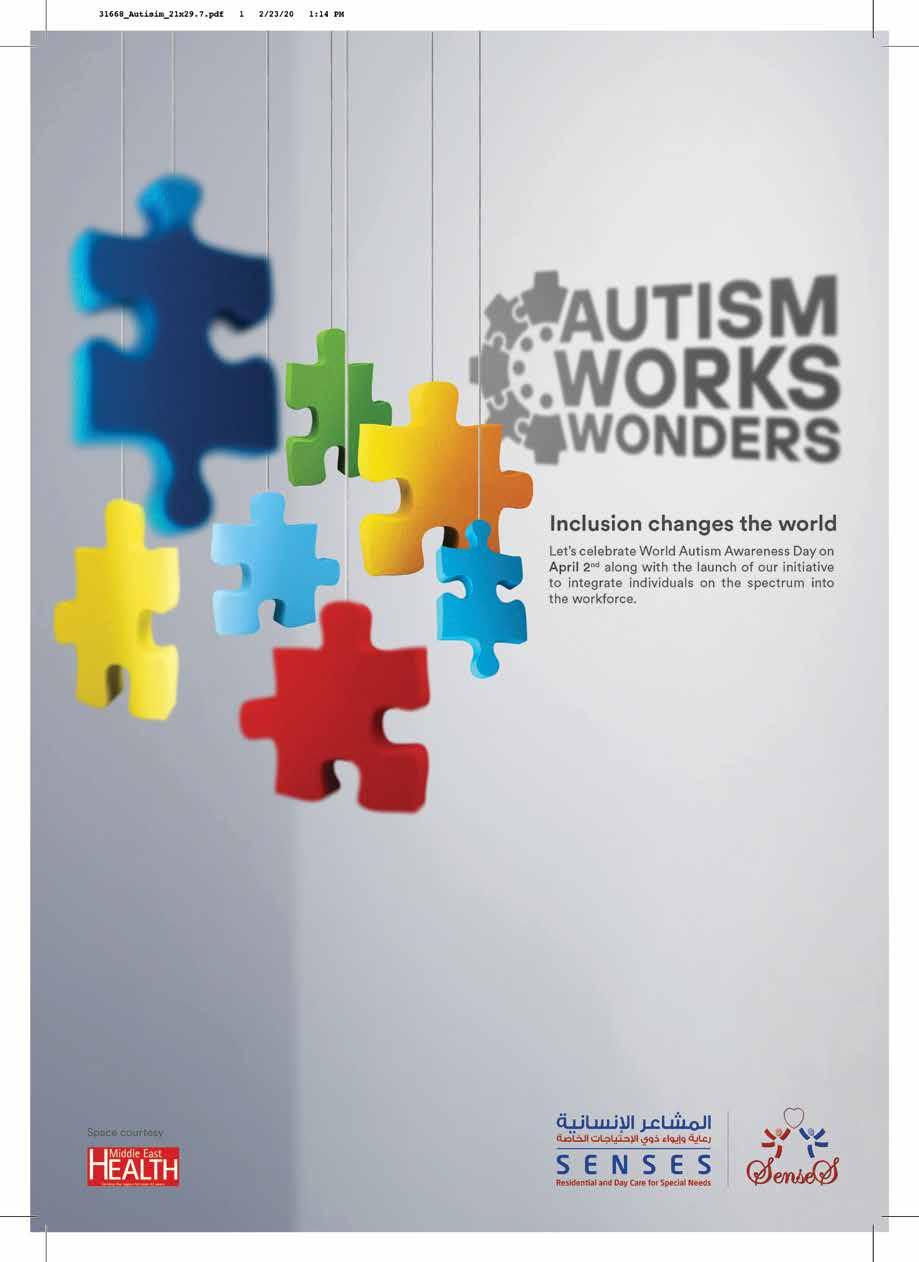
Women’s Health
Healthcare providers urged to rethink treatment for female amputees
Women with limb loss have unique physi cal and psychosocial needs, meaning pro viders treating this population must adapt their healthcare delivery approach, says new research presented at Physiatry ’23, the As sociation of Academic Physiatrists (AAP) annual meeting.
There is a growing population of wom en with limb loss, yet limited research is available to provide evidentiary sup port for clinical decision-making in this demographic. To investigate the unique impact of limb loss on women, including physical and psychosocial needs, a group of researchers from the U.S. Department of Veterans Affairs (VA) and Department of Defense (DoD) healthcare systems and private sector administered an online needs assessment to female amputees.
“This lack of research presents a sig nificant challenge for clinicians and phy sicians to address the needs of women with limb loss that may vary from men,” says Dr Roxanne Disla, an occupational therapist at the James J. Peters VA Medi cal Center in the Bronx, N.Y., and the study’s presenting author. “Furthermore, male structure and biomechanics tend to be the base for most prosthetic devices. As a result, women with limb loss tend to face significant challenges such as illfitting prostheses, skin issues and an in creased risk of other health problems.”
In the new study, a convenience sam ple of 115 female and 93 male amputees completed the online needs assessment consisting of a bank of existing limb lossand non-limb loss-specific surveys, which were categorized around domains of general health, quality of life, prosthetic use/ needs, psychosocial health and behaviours, and body image. These surveys were supplemented with written items to ensure
the usefulness/reliability of their prosthesis than men. The researchers also found that women with limb loss were less satisfied with appearance compared to men, reported less ease in social situations, higher
limb loss to evolve healthcare delivery and research practices, as well as work jointly with industry in order to meet the unique needs of this population, the researchers concluded.

20 IMIDDLE EAST HEALTH
New research finds labour induction doesn’t always reduce caesarean birth risk or improve outcomes for term pregnancies
In recent years, experts have debated whether most birthing individuals would benefit from labour induction once they reach a certain stage of pregnancy.
But a new statewide study in Michigan, U.S., suggests that inducing labour at the 39th week of pregnancy for people having their first births with a single baby that is in a head down position, or low risk, doesn’t necessarily reduce the risk of caesarean births. In fact, for some birthing individuals, it may even have the opposite effect if hospitals don’t take a thoughtful approach to induction policies.
“Some people in the field have suggested that after 39 weeks of gestation, medical induction should be standard practice,” said lead author Elizabeth Langen, M.D., a high-risk maternal foetal medicine physician and researcher at University of Michigan Health Von Voigtlander Women’s Hospital, of Michigan Medicine.

“We collaborated with peer hospitals to better understand how labour induction
may influence caesarean birth outcomes in real world maternity units outside of a clinical trial. In our study sample, we found inducing labour in this population of women and birthing people did not reduce their risk of caesarean birth.”
The new research, published in the American Journal of Perinatology [1], was based on more than 14,135 deliveries in 2020 analyzed through a statewide maternity care quality collaborative registry. The collaborative, known as the Obstetrics Initiative and which began in 2018, includes at least 74 birthing hospitals and centres on reducing primary caesarean birth rates in low-risk pregnancies.
Results conflict with ARRIVE trial findings
The study was conducted in response to published research in 2018 from a multicentre trial known as “ARRIVE” (A Randomized Trial of Induction Versus Expectant Management.)
Findings from ARRIVE indicated that medical induction at 39 weeks’ gestation in first time low risk pregnancies resulted in a lower rate of caesarean deliveries compared to expectant management – or waiting for labour to occur on its own or for a medical need for labour induction.
Michigan researchers mimicked the same framework used in the national trial and analyzed data from the collaborative’s data registry, comparing 1,558 patients who underwent a proactively induced labour versus 12,577 who experienced expectant management.
“We designed an analytic framework mirroring the previous trial’s protocol using retrospective data, but our results didn’t reinforce a link between elective induced labour in late pregnancy and a reduction in caesarean births,” said senior author and U-M professor of nursing Lisa Kane Low, Ph.D., C.N.M., a midwife and researcher at Michigan Medicine and the U-M School of Nursing.
MIDDLE EAST HEALTHI 21
Patricia Prudente / Unsplash
Women’s Health
In fact, results from the general Michigan sample were contradictory to the ARRIVE trial: Women who underwent elective induction were more likely to have a caesarean birth compared with those who underwent expectant management (30% versus 24%.)
In a subset of the sample, matching patient characteristics for a more refined analysis, there were no differences in csection rates. Authors noted that time between admission and delivery was also longer for those induced.
Expectantly managed women were also less likely to have a postpartum haemorrhage (8% versus 10%) or operative vaginal delivery (9% versus 11%), whereas women who underwent induction were less likely to have a hypertensive disorder of pregnancy (6% versus 9%.) There were no other differences in neonatal outcomes.
Explanations for conflicting findings
Authors point to several possible explanations for why the tw o studies had conflicting results. One key difference was that the Michigan study collected data after births for the purpose of quality improvement in a general population of low-risk births. The ARRIVE trial, however, used data collected in real time as part of a research study.
A significant difference between indi-
viduals in a clinical trial and the general birthing population, Low says, may revolve around shared decision-making. Before trial enrolment, participants undergo a thorough informed consent process from trained study team members.
For the ARRIVE trial, this meant 72% of women approached to be in the study declined participation. Meanwhile, previous research has indicated that women in the general U.S. population often may feel pressured into agreeing to have their labour induced.
“Better outcomes may have occurred in the trial because the participants were fully accepting of this process,” Low said.
“Further research is needed to identify best practices to support people undergoing labour induction,” she added. “Prior to initiating an elective induction of labour policy, clinicians should also ensure resources and a process to fully support shared decision-making.”
Inequities impacting likelihood of induced labour
Michigan researchers also found that the practice of inducing labour at 39 weeks was not applied equally across demographic groups, with those being induced more likely to be birthing people who are at least 35 years old, identify as White nonHispanic and who are privately insured.
The racial disparity in the data is consistent with the Centers for Disease Control and Prevention (CDC) data that shows more white women undergo induced labour than birthing individuals of any other racial or ethnic group.
“These findings suggest that the practice of elective induction of labour may not be equitably applied across birthing people,” Langen said. “We can only speculate about the reasons for these differences, but it’s important that we pursue equitable application of evidencebased practices for all who would benefit.”
Hospitals across the Michigan collaborative varied in size, teaching status and location but the sample size for induced deliveries was not adequate to analyze the impact of specific hospital factors on outcomes, authors note.
However, the team’s additional analysis found caesarean birth rate after induced delivery did not differ between large hospitals and the rest of the collaborative.
“Inductions of labour for both medical indications and individual preferences will continue to be part of modern obstetrics, making it important to pursue strategies that optimize the induction process and outcomes,” Langen said. “Future work should include a health equity approach and include the voices of pregnant people and their experiences of changes in care management.”
Reference:
Emotional wellbeing may be linked to women’s gut health
Specific species of bacteria were present with higher abundances in women who reported being happier, more hopeful and having better emotion management skills
A new study by investigators from Brigham and Women’s Hospital, a founding member of the Mass General Brigham healthcare system, and the Harvard T.H. Chan School of Public Health has linked bacteria in our gut to positive emotions like happiness and hopefulness and healthier emotion management skills. Their results were published recently in Psychological Medicine [1] .
Previous research has found that the brain communicates with the gastrointestinal tract through the gut-brain axis. One theory is that the gut microbiome plays a starring role in the gut-brain axis, linking physical and emotional health.
“The gut contains trillions of microorganisms collectively known as the gut microbiome. Many studies have shown that disturbance in the gut microbiome can affect the gut-brain axis and lead to various health problems, including anxiety, depression and even neurological disorders,” said co-corresponding author Yang-
Yu Liu, PhD, an associate scientist in the Brigham’s Channing Division of Network Medicine and an associate professor of Medicine at the Harvard Medical School.
“This interaction likely flows both ways – the brain can impact the gut, and the gut can impact the brain. The emotions that we have and how we manage them could affect the gut microbiome, and the microbiome may also influence how we feel.”, said first author Shanlin Ke, PhD, who worked on the study as a postdoctoral researcher in Liu’s lab.
The gut-brain axis might affect physical s
22 IMIDDLE EAST HEALTH
1. Langen ES, Schiller AJ, Moore K, et. al. Outcomes of Elective Induction of Labor at 39 Weeks from a Statewide Collaborative Quality Initiative. Am J Perinatol. February 16, 2023. doi: https://doi.org/10.1055/s-0043-1761918.
Obesity risk may pass from mothers to daughters
Women with obesity may share risk for the disease with their daughters, but not their sons, according to a new study published in the Endocrine Society’s Journal of Clinical Endocrinology & Metabolism.
Obesity is a common, serious and costly disease. In 2016 it is estimated that 15% of women worldwide were obese according to the World Health Organisation and the prevalence of obesity continues to increase.
People with obesity are at higher risk of developing diabetes, high blood pressure, heart issues, and many other conditions.
Commenting on the study, Rebecca J. Moon, B.M., Ph.D., M.R.C.P.C.H., of the MRC Lifecourse Epidemiology Centre, University of Southampton in Southampton, U.K., said: “These findings highlight that girls born to mothers who
health, as well. Previous research has shown that positive emotions and healthy emotional regulation are linked to greater longevity. In contrast, negative emotions are linked to higher rates of cardiovascular disease and mortality from all causes, according to study co-corresponding author Laura Kubzansky, PhD, a professor of Social and Behavioral Sciences in the Department of Social and Behavioral Sciences at the Harvard T.H. Chan School of Public Health.
The new study included more than 200 women from the Mind-Body Study, a substudy of the Nurses’ Health Study II. These middle-aged, mostly white women filled out a survey that asked about their feelings in the last 30 days, asking them to report positive (feeling happy or hopeful about the future) or negative (feeling sad, afraid, worried, restless, hopeless, depressed, or lonely) emotions they’d had. The survey also assessed how they handled their emotions. The two options were reframing the situation to see it in a more positive light (cognitive reappraisal) or holding back from expressing their negative emotions (suppression). Suppressing one’s feelings is often a less effective way of handling them
have obesity or have high amounts of body fat may be at higher risk of gaining excess body fat themselves. Further studies are needed to understand why this is happening, but our findings suggest that approaches to addressing body weight and composition should start very early in life, particularly in girls born to mothers with obesity and overweight.”
The researchers measured body fat and muscle in 240 children (9 years old or younger) and their parents in early childhood. They used this data to determine whether the body mass index (BMI) – a screening tool for overweight and obesity – and the amount of body fat and muscle in the child was related to that of their parents.
They found the girls had similar BMI and fat mass to their mothers, suggesting that girls born to mothers who have obesity or have high fat mass are at high risk of also develop-
and can lead to worse mental and physical health outcomes, co-first author AnneJosee Guimond, PhD, who worked on the study as a postdoctoral researcher in Kubzansky’s lab, said.
Three months after answering the survey, the women provided stool samples. The stool samples were analyzed using metagenomic sequencing. The team compared the results from the microbial analysis to the survey responses about emotions and ways of managing them to look for connections.
“Some of the species that popped up in the analysis were previously linked with poor health outcomes, including schizophrenia and cardiovascular diseases,” Guimond said. ” These links between emotion regulation and the gut microbiome could affect physical health outcomes and explain how emotions influence health.”
The analysis found that people who suppressed their emotions had a less diverse gut microbiome. They also found that people who reported happier feelings had lower levels of Firmicutes bacterium CAG 94 and Ruminococcaceae bacterium D16. On the other hand, people who
ing obesity or overweight. The researchers did not find the same association between boys and their mothers or either girls or boys and their fathers.
The study received funding from the Medical Research Council, the British Heart Foundation, the NIHR Southampton Biomedical Research Centre, the NIHR Oxford Biomedical Research Centre, the Seventh Framework Program, the Biotechnology and Biological Sciences Research Council, the Horizon 2020 Framework Program, and the National Institute on Aging.
• The study, “Parent-Offspring Associations in Body Composition: Findings from The Southampton Women’s Survey Prospective Cohort Study,” was published online, ahead of print. https://doi.org/10.1210/clinem/dgad128
had more negative emotions had more of these bacteria.
“I was intrigued that positive and negative emotions often had consistently similar findings in opposite directions,” Kubzansky said. “This is what you would expect, but kind of amazing to me that we saw it.”
The researchers also examined what the microbes in the gut were doing on a functional pathway level, looking for links between changes in the capacity of this activity and specific emotional states and emotion regulation methods. They found that negative emotions were linked to lowered capacity activity in multiple metabolism-related actions.
This study was limited in that its subjects were mostly postmenopausal white women. The emotion survey was also done at one point in time so that the researchers couldn’t decipher the direction of the link. The researchers want to repeat the study with more diverse populations, a more extensive emotional survey, and longitudinal data. A more specific analysis of the microbial strains might also help develop microbiome-based therapeutics like probiotics to improve emotions and well-being.
Reference:
1. Ke, Shanlin et al. “Gut feelings: associations of emotions and emotion regulation with the gut microbiome in women.” Psychological medicine, 1-10. March 21, 2023. doi: https://doi.org/10.1017/S0033291723000612
MIDDLE EAST HEALTHI 23
Sheikh Shakhbout Medical City
Shakhbout Medical City provides advanced, multidisciplinary care for breast cancer patients
Introduction
Breast cancer is the most commonly diagnosed cancer in the UAE and, in 2020, it accounted for 38.8% of cases in women of all ages [1]. As the designated lead for cancer services within the SEHA network, Sheikh Shakhbout Medical City (SSMC) has invested greatly into providing comprehensive and holistic care for our cancer patients, especially those with breast cancer, in the UAE.
Through a multidisciplinary approach, the team of locally and internationally trained physicians at SSMC work seamlessly together, supported by cutting-edge research and technologies, to provide integrated humancentric and compassionate care.
The need for early screening and the process – Dr. Holland Ravelle, consultant radiologist, chair of Clinical Imaging, Sheikh Shakhbout Medical City
“Detecting breast cancer early is critical because, when found early, it becomes easier to treat. Generally, we’ve found that women who live a healthy, active lifestyle and regularly undergo screening once they reach the age of 40 have higher chances of early detection and better treatment outcomes.
“When it comes to the screening process, doctors perform a mammogram, which is an X-ray picture of the breast. During this, a patient’s breasts are compressed between two firm surfaces and an X-ray captures black-and-white images, which are examined for signs of cancer.

“Over the last few years, SSMC has launched several campaigns and initiatives to increase regular screening in women over the age of 40 for earlier detection and treatment.”
Types of treatment and SSMC’s support group – Dr. Aisha Al Salami, consultant oncologist, Sheikh Shakhbout Medical City
“Treatment really depends on the patient, the type of breast cancer and stage of diagnosis, and it is common for patients with breast cancer to get more than one kind of treatment. These treatment options vary and can include a combination of surgery to remove cancer tissue and che-
motherapy to shrink and kill cancer cells. There are also several types of therapies as well, such as hormonal therapy, which blocks cancer cells from getting the hormones they need to grow, biological therapy, which collaborates with the body’s immune system to help it fight cancer cells, and radiation therapy, which uses highenergy rays to kill cancerous cells.
“As one of the largest hospitals in the country, SSMC provides access to the latest diagnostic and treatment modalities available for comprehensive cancer care, especially breast cancer, bringing advanced and trusted quality care closer to cancer patients in the UAE and wider region.
“Last year, we also launched our very own breast cancer support group to bring women and their families together to hear their empowering stories and learn about their journeys. The sessions were a fantastic success and helped to drive the message of hope and strength to women fighting breast cancer here in the UAE.”
Surgical treatment options – Dr. Nahed Balalaa, consultant breast cancer surgeon, Sheikh Shakhbout Medical City “Breast cancer is a life-changing diagnosis that not only has a physical effect on the body, but also a mental one. Providing holistic care means going beyond just treatment that eliminates cancer, but also addressing the outward effects of the disease as well.
“When it comes to surgery, there are several options. Depending on the patient’s condition, breast conservation can be utilized to keep the breast and only remove the cancerous tissue itself. Additionally, there is also the option of breast
reconstruction, which includes two types: immediate reconstruction and delayed reconstruction. This type of surgery depends on the cancer stage, medical condition, and any additional therapies required after the surgery.”
Importance of public awareness and education – Farah, Emirati breast cancer survivor
“When I was first diagnosed with breast cancer, I felt lost because I had zero medical knowledge and information about the disease. I really did not know what to do. It wasn’t until later in my journey that I was able to learn more about the disease and treatment options, which was very useful when I was diagnosed with breast cancer once again and had to undergo chemotherapy and surgery.
“My message to women would be: Educate yourself and focus on your health because breast cancer is not the end of the world. Never give up and always have hope that you can beat it.”
Conclusion
The rise in breast cancer rates among women remains a pressing healthcare issue, and the team at SSMC is committed to elevating the provision of cancer care services and standards in the UAE. The hospital’s unique model of care and multidisciplinary approach means that it is better placed to be able to address the needs of patients and provide improved treatment outcomes.
References:
24 IMIDDLE EAST HEALTH
Sheikh
1. https://gco.iarc.fr/today/data/factsheets/ cancers/20-Breast-fact-sheet.pdf

Trust, which provides clinical excellence combined with the highest standards of care at one of the UK’s best-known, largest and most prestigious teaching hospitals.
We provide access to the most comprehensive range of advanced surgical, medical and diagnostic facilities offering specialist care from before birth to childhood and into adult life. Our unique women’s health service provides joined up care for women and children all at one hospital Trust.

Fertility is just one of many fields in which our pioneering research has made a significant difference in enhancing health provision. Indeed, two of our fertility services are at the forefront of innovation –our ovarian tissue cryopreservation (OTC) service and our well-established centre for pre-implantation genetic testing (PGT).
Fertility preservation
Ovarian tissue cryopreservation offers female patients the opportunity to preserve their fertility before undergoing treatment such as chemo-radiotherapy or stem cell transplants that could make them infertile.
A gynaecologist will collect the ovarian tissue through keyhole surgery before or during chemotherapy. Then, after a safe interval, and when the patient is ready to start a family, they re-implant the ovarian tissue in the pelvis.
Using ovarian tissue is faster than other
OTC’s other advantage is that it gives women the chance to restore their menstrual cycle and conceive naturally, although many will still need in vitro fertilisation (IVF).
Dr Julia Kopeika, clinical lead for the fertility service at Guy’s and St Thomas’, said: “We are delighted that we are able to offer life-changing treatment for young girls and women and the opportunity to preserve their fertility after gonadotoxic treatment.”
Guy’s and St Thomas’ recently expanded its OTC service not only to adults but also to children who are having gonadotoxic treatment the opportunity to freeze their ovaries at the world-renowned Evelina London Children’s Hospital.
Pre-implantation genetic testing
Another innovative treatment that has changed the face of fertility is our pre-implantation genetic testing service (PGT), which is part of the globally respected Assisted Conception Unit (ACU) at Guy’s Hospital.
Guy’s and St Thomas’ has offered PGT since 1997 and is the largest and most successful PGT centre in the UK. The Human Fertilisation and Embryology Authority has licenced the service to research further improvements in treatment outcomes for our patients.
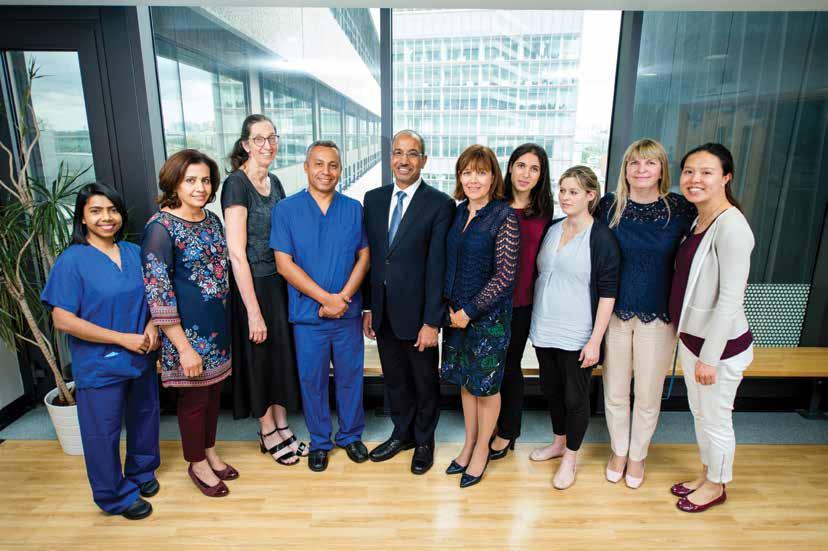
PGT is a type of IVF offered to couples at
cific genetic disorder. We test for 300 genetic conditions, including many widespread in the Middle East, such as sickle cell disease, cystic fibrosis and alpha thalassemia.
Embryologists perform the embryo biopsy step in PGT, removing a sample of cells from an embryo to test if they are affected by a genetic condition. Then, only the unaffected embryos are returned to the womb to avoid passing on the disorder to a child as pregnancy hopefully develops.
Our ACU is dedicated to improving patient outcomes and runs an extensive research portfolio of academic and commercial clinical trials. In addition, our leading consultants contribute to research and scientific evidence that continually drives forward innovations in the world of fertility.
• Contact us to find out more about our fertility services:
T: +44 (0)20 7188 2300
E: acupersonalisedcare@gstt.nhs.uk
www.guysandstthomasprivateheatlhcare.co.uk

26 IMIDDLE EAST HEALTH

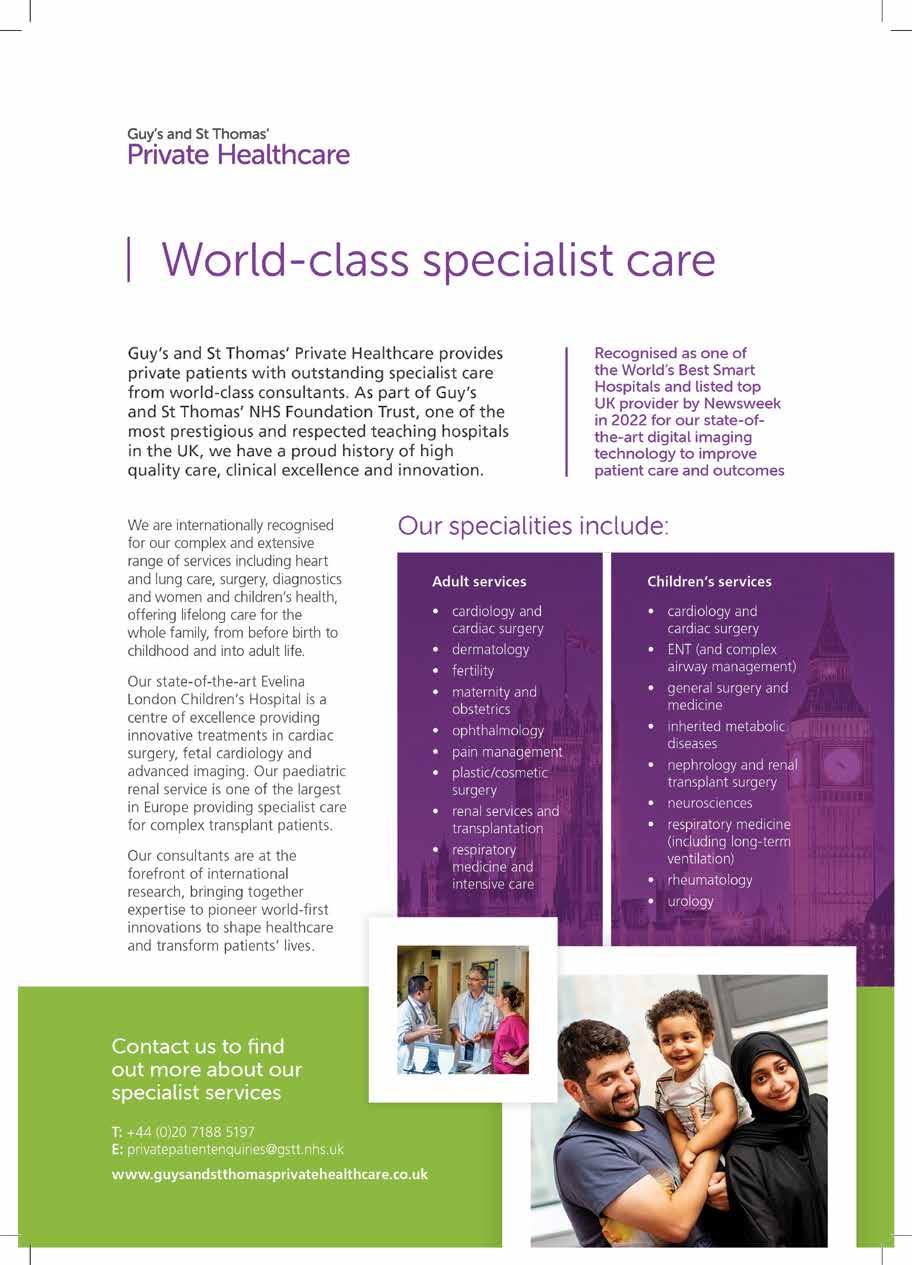 Wolters Kluwer
Wolters Kluwer
Aligning care decisions across the patient journey

Providing an elevated patient experience is more than just an opportunity in today’s environment: It’s a mandate for healthcare organizations moving forward. Healthcare leaders are facing staff shortages, burnout, financial pressures, and new competition from retail and consumer brands, all while encountering demand for an improved patient experience.
These challenges are increasingly difficult to navigate. Fortunately, there are tools and strategies that can help clinicians along the way.
What’s driving the need to improve
Patients are increasingly demanding a better experience when they encounter the healthcare system — from beginning to end, not just during the times when they’re actively being seen by a provider. Unwanted variability of care occurs when decisions and medical information aren’t coordinated and consistent across the care continuum.
Healthcare organizations are learning how to better understand these demands and address inconsistencies in care.
“Consumers are not satisfied,” said Peter Bonis, M.D., Chief Medical Officer at Wolters Kluwer Health. “Interacting with the healthcare system is very difficult right now, and collectively as individuals, they are saying, ‘We want more options, and we want this to be done better.’ And the market is beginning to respond.”
Another factor that’s driving the need to provide patients with an elevated experience is a historically challenging financial picture. Becoming more patientfriendly is part of a journey to deliver more cost-effective service lines that can lead to sustainable and profitable growth. That means more of a shift from care and the inpatient setting to care in the ambulatory
setting, and that requires new sets of capa bilities and new technologies.
One of the most compelling reasons for providers to improve is new commercial and retail competitors that are offering consumer-friendly care choices. These competitors affect patient choices differently depending on location because many are not offered nationwide, but some also have virtual of ferings, so they have a collective influence on where people seek care.
Virtual care and other options are be coming popular. Research shows that 45% of adults have received care at a nontradi tional care venue, and most of them used one in the past year. pursued nontraditional care, 95% indicated they would visit again in the future. of that, patients are “much more tech-savvy and willing to try these things,” Bonis said.
It remains to be seen whether these options are sustainable, though, which could provide an advantage for more traditional providers.
Where healthcare organizations should focus Healthcare leaders face competing priori ties every day, from improving efficiencies to reducing costs, improving clinician
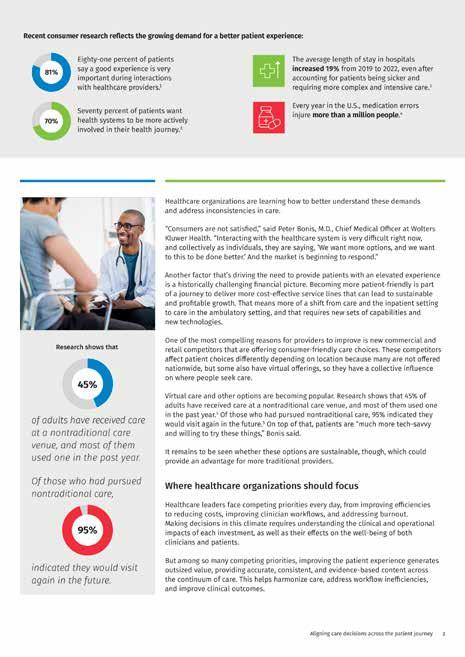

Eighty-one percent of patients say a good experience is very important during interactions with healthcare providers.1


Seventy percent of patients want health systems to be more actively involved in their health journey.2
The average length of stay in hospitals increased 19% from 2019 to 2022, even after accounting for patients being sicker and requiring more
Every year in the U.S., medication errors injure more than a million
28 IMIDDLE EAST HEALTH
Research shows that of adults have received care at a nontraditional care venue, and most of them used one in the past year. Of those who had pursued nontraditional care, indicated they would visit again in the future.
outsized value, providing accurate, consistent, and evidence-based content across the continuum of care. This helps harmonize care, address workflow inefficiencies, and improve clinical outcomes.
Meeting patients where they are
Patient engagement and satisfaction continue to remain important and critical aspects of the patient journey. Addressing the needs of patients requires your care teams to adjust some of the ways in which they interact and communicate with them before, during, and after a visit.

These changes are often enabled by new technology tools such as portals, patientfacing apps and virtual visit platforms. Patients are increasingly comparing their experiences interacting with a care team with digital experiences from other aspects of their lives such as banking, shopping, and ordering food. Thus, meeting patients where they are also means improving the transactional parts of their journey.
Keys to providing an elevated patient experience

Information is at the heart of every clinical decision, treatment plan, and patient experience. That’s why care teams need accurate information and tools to deliver exceptional care throughout the patient journey.
Clinical Decision Support (CDS) tools can provide a foundation for this process. Healthcare systems have been adopting CDS solutions to make more accurate, consistent, better-informed decisions, which lead to improved quality metrics and patient outcomes. These tools can also connect encounters throughout the patient experience. They
Healthcare organizations can benefit by focusing on these priorities:
Aligning care decisions for better patient outcomes. Ensure that your care teams have the most accurate, evidencebased information and tools they need to deliver exceptional care to patients when they need it throughout the patient journey.
Mitigating clinician burden and burnout. This was a top concern before the COVID-19 pandemic, but it is of particular importance now because most other objectives cannot be achieved with a workforce that is overburdened and burned out.
Reducing friction for patients and clinicians. Being able to access trusted, understandable medical information quickly and easily reduces the complexity of the process and leads to higher patient and clinician satisfaction.
With the proper tools, care teams can quickly look up medication information to learn about potential side effects and how multiple drugs work together, all without interrupting the patient visit.
A strategy for success
improve clinical workflows by providing content quickly within the electronic medical record/electronic health record whenever it’s needed by clinicians. Other benefits include streamlining care, improving efficiencies for clinicians, enabling care continuity, and improving patient outcomes, efficiencies, and cost savings.
Accurate, reliable drug information and clinical content play a critical role in building trust throughout the patient experience.
References
1. 81% of Consumers Say a Good Patient Experience is Very Important When Interacting with Healthcare Providers. Business Wire. Oct. 4, 2022. Retrieved Dec. 19, 2022, from https://www.businesswire.com/news/ home/20221004005044/en/81-of-Consumers-Saya-Good-Patient-Experience-is-Very-ImportantWhen-Interacting-with- Healthcare-Providers.

2. As Consumers Reject “One-Size-Fits-All” Mindset, U.S. Healthcare Struggles to Keep Up. Kaufman Hall. Sept. 27, 2022. Retrieved Dec. 18, 2022, from https://www. kaufmanhall.com/ news/consumers-reject-one-size-fits-all-mindset-ushealthcare-struggles-keep.
Patients deserve to receive accurate, consistent, and understandable information at every point of care. Three of the most effective tools for the clinician to make this happen are CDS solutions, drug referential content, and patient engagement platforms. Doing so can result in lower costs, better patient outcomes, higher patient satisfaction scores, optimization of clinicians’ time, and reduced care team burden. Leaders that take advantage of effective tools and strategies will be in the best position to create a higher-quality patient experience from beginning to end and deliver optimal care.
in hospitals up 19%. Healthcare Finance News. Dec. 8, 2022. Retrieved Jan. 20, 2023, from https://www.healthcarefinancenews. com/news/ahaaverage-length-stay-hospitals-19
4. WHO launches global effort to halve medication-related errors in 5 years. World Health Organization. March 29, 2017. Retrieved Jan. 19, 2023, from https://www.who.int/ news/item/29-03-2017-who-launches-global-effortto-halve-medication-related-errors-in-5-years
5. 2022 Stericycle Communication Solutions
U.S. Consumer Trends In Patient Engagement Survey. Stericycle Communication Solutions. Retrieved Dec. 17, 2022, from https:// engage. stericyclecommunications.com/2022-us-consumerhealthcare-trends-survey

 3. Lagasse, Jeff. AHA: Average length of stay
3. Lagasse, Jeff. AHA: Average length of stay
MIDDLE EAST HEALTHI 29
Genetics
The new pangenome reference is a collection of different genomes from which to compare an individual genome sequence. Like a map of the subway system, the pangenome graph has many possible routes for a sequence to take, represented by the different colours. The detouring paths at the top of the image represent single nucleotide variants (SNVs), which are single letter differences. The yellow path that loops around itself and repeats the same nucleotides represents a duplication variant. The pink path that loops counterclockwise and follows the nucleotide sequence backwards represents an inversion variant. At the bottom, the green and dark blue paths miss the C nucleotide in its route and represent a deletion variant. The light blue path, which has extra nucleotides in its route, represents an insertion variant.
Scientists release a new human “pangenome” reference
More complete and sophisticated collection of genome sequences captures significantly more human diversity

Researchers have released a new high-quality collection of reference human genome sequences that captures substantially more diversity from different human populations than what was previously available. The work was led by the international Human Pangenome Reference Consortium, a group funded by the US-based National Human Genome Research Institute (NHGRI), part of the National Institutes of Health.
The new “pangenome” reference in-
cludes genome sequences of 47 people, with the researchers pursuing the goal of increasing that number to 350 by mid-2024. With each person carrying a paired set of chromosomes, the current reference actually includes 94 distinct genome sequences, with a goal of reaching 700 distinct genome sequences by the completion of the project.
The work, appearing in the journal Nature [1], is one of several papers published by consortium members.
What is the genome?
A genome is the set of DNA instructions that helps each living creature develop and function. Genome sequences differ slightly among individuals. In the case of humans, any two peoples’ genomes are, on average, more than 99% identical. The small differences contribute to each person’s uniqueness and can provide insights about their health, helping to diagnose disease, predict outcomes and guide medical treatments.
30 IMIDDLE EAST HEALTH
Darryl Leja, National Human Genome Research Institute, NIH
Genetics
To understand these genomic differences, scientists create reference human genome sequences for use as a “standard” –a digital amalgamation of human genome sequences that can be used as a comparison to align, assemble and study other human genome sequences.
The original reference human genome sequence is nearly 20 years old and has been regularly updated as technology advances and researchers fix errors and discover more regions of the human genome. However, it is fundamentally limited in its representation of the diversity of the human species, as it consists of genomes from only about 20 people, and most of the reference sequence is from only one person.
“Everyone has a unique genome, so using a single reference genome sequence for every person can lead to inequities in genomic analyses,” said Adam Phillippy, Ph.D., senior investigator in the Computational and Statistical Genomics Branch within NHGRI’s Intramural Research Program and a co-author of the main study. “For example, predicting a genetic disease might not work as well for someone whose genome is more different from the reference genome.”
Long-read DNA sequencing
The current reference human genome sequence has gaps that reflect missing information, especially in areas that were repetitive and hard to read. Recent technological advances such as long-read DNA sequencing, which reads longer stretches of the DNA at a time, helped researchers fill in those gaps to create the first complete human genome sequence. This complete human genome sequence, released last year as part of the NIH-funded Telomere-to-Telomere (T2T) consortium, is incorporated into the current pangenome reference. In fact, many of the T2T researchers are also members of the Human Pangenome Reference Consortium.
Using advanced computational techniques to align the various genome sequences, the researchers constructed a new human pangenome reference with each assembly in the pangenome covering more than 99% of the expected sequence with more than 99% ac-
curacy. It also builds upon the previous reference genome sequence, adding over 100 million new bases, or “letters” in DNA. While the previous reference genome sequence was single and linear, the new pangenome represents many different versions of the human genome sequence at the same time. This gives researchers a wider range of options for using the pangenome in analyzing other human genome sequences.
“By using the pangenome reference, we can more accurately identify larger genomic variants called structural variants,” said Mobin Asri, a Ph.D. student at the University of California Santa Cruz and co-first author of the paper. “We are able to find variants that were not identified using previous methods that depend on linear reference sequences.”
Structural variants in each human genome
Structural variants can involve thousands of bases. Until now, researchers have been unable to identify the majority of structural variants that exist in each human genome using short-read sequencing due to the bias of using a single reference sequence.
“The human pangenome reference will enable us to represent tens of thousands of novel genomic variants in regions of the genome that were previously inaccessible,” said Wen-Wei Liao, a Ph.D. student at Yale University and co-first author of the paper. “With a pangenome reference, we can accelerate clinical research by improving our understanding of the link between genes and disease traits.”
The total cost of supporting the work of the Human Pangenome Reference Consortium is projected to be about $40 million over five years, which includes efforts to create the human pangenome reference, improve DNA sequencing technology, operate a coordinating
centre, conduct outreach and create resources for the research community to use the pangenome reference.
Many of the individuals whose genomes were sequenced for constructing the new human pangenome reference were originally recruited as part of the 1,000 Genomes Project, a collaborative and international effort funded in part by NIH that aimed to improve the catalogue of genomic variants in diverse populations. Because the human pangenome reference is a work in progress, researchers from the international Human Pangenome Reference Consortium continue to add more genome sequences to increasingly improve the quality of the pangenome reference.
“Basic researchers and clinicians who use genomics need access to a reference sequence that reflects the remarkable diversity of the human population. This will help make the reference useful for all people, thereby helping to reduce the chances of propagating health disparities,” said Eric Green, M.D., Ph.D., NHGRI director. “Creating and enhancing a human pangenome reference aligns with NHGRI’s goal of striving for global diversity in all aspects of genomics research, which is crucial to advance genomic knowledge and implement genomic medicine in an equitable way.”
In line with this effort, the Human Pangenome Reference Consortium includes an embedded ethics group that is working to anticipate challenging issues and help guide informed consent, prioritize the study of different samples, explore possible regulatory issues pertaining to clinical adoption, and work with international and Indigenous communities to incorporate their genome sequences in these broader efforts.
Reference:
1. doi: https://doi.org/10.1038/s41586-02305896-x
MIDDLE EAST HEALTHI 31
Basic researchers and clinicians who use genomics need access to a reference sequence that reflects the remarkable diversity of the human population. This will help make the reference useful for all people, thereby helping to reduce the chances of propagating health disparities.
The United States leads the way in global MedTech R&D
The United States is a global leader in MedTech research and development, with a long history of innovation and breakthroughs. Recent advances in technology, such as artificial intelligence, 3D printing and virtual reality, have opened up new possibilities for improving patient outcomes, developing new treatments and cures, and enhancing surgical training.
The United States leads the way in MedTech research and development due to several factors, including a strong scientific and technological base, a favourable regulatory environment, significant private and public investment in research and development, and a vibrant startup ecosystem.

The US has a large and highly skilled workforce, with many of the world’s top scientists, researchers, and engineers based in the country. It is also home to many of the world’s leading universities and research institutions, which play a critical role in driving innovation in MedTech.
In terms of regulatory environment, the US Food and Drug Administration is considered the gold standard for regulatory agencies in the world, with strict but fair regulations that ensure the safety and efficacy of medical devices and treatments. This regulatory framework encourages innovation by providing clear guidelines for developers and investors to follow.
There is also a significant amount of private and public investment in MedTech research and development, with large pharmaceuti-
What is bioprinting?
cal and medical device companies investing heavily in R&D, and government agencies like the National Institutes of Health and the National Science Foundation providing grants to support innovation in MedTech.
In addition, the US has a vibrant startup ecosystem, with many pioneering companies emerging from Silicon Valley and other tech hubs around the country. These startups are driving innovation in areas like wearable health technology, telemedicine, and personalized medicine.
Major MedTech developments
Some major MedTech developments that have come out of the US include:
CRISPR gene editing technology: Developed by Jennifer Doudna and Emmanuelle Charpentier, this breakthrough technology allows for precise editing of genes, potentially allowing for the treatment of genetic diseases.
Wearable health technology: Companies like Fitbit and Apple are leading the way in developing wearable health technology that can track vital signs like heart rate and blood pressure, as well as monitor
Bioprinting is a relatively new technology that involves using 3D printers to create complex structures made up of living cells. The process begins with a computer-aided design (CAD) model of the desired structure, which is then converted into a series of instructions that are sent to the printer.
Instead of using ink or plastic, bioprinters use a special type of bioink that is made up of living cells suspended in a gel-like substance. The printer deposits the bioink layer by layer, creating a 3D structure that is capable of growing and functioning like natural tissue.
Bioprinting has the potential to revolutionize the field of regen-
sleep patterns and physical activity.
Telemedicine: Companies like Teladoc <www.teladochealth.com> and Doctor on Demand < https://doctorondemand.com > are making it easier for patients to access medical care remotely, through video consultations with doctors and other medical professionals.
3D Printing: 3D printing technology has advanced to the point where it can be used to create custom implants and prostheses. For example, medical researchers at Northwestern University developed a 3D-printed ovary that was implanted in mice, restoring their fertility. And most recently researchers at MIT have 3Dprinted a patient-specific heart <https://bit. ly/3LXoR5P> for use in personalised cardiac surgery planning. A 3D model of the patient-specific heart was developed based on CT and MRI images.
Bioprinting: Bioprinting is a form of 3D printing that uses living cells to create tissue and organ structures. This technology has the potential to revolutionize the field of regenerative medicine by allowing for the creation of functional organs for transplantation.
erative medicine by allowing researchers to create functional tissues and organs for transplantation. For example, researchers have already used bioprinting to create functional liver tissue and heart valves.
However, there are still many challenges to overcome before bioprinting can be used on a large scale. One of the biggest challenges is ensuring that the printed tissues and organs are able to survive and function properly once transplanted into the body. Nonetheless, bioprinting is a rapidly advancing field, and researchers are working to overcome these challenges and unlock its full potential.
32 IMIDDLE EAST HEALTH
United States Report
s

United States Report
Artificial Intelligence (AI): AI is being used in the medical industry to improve diagnosis and treatment. For example, Google’s DeepMind is developing an AI system that can help doctors diagnose eye disease, and IBM’s Watson Health is using AI to help identify personalized cancer treatments.
A particularly promising area of AI in medicine is image analysis. Medical images, such as x-rays, CT scans, and MRIs, are complex and difficult for humans to interpret accurately. However, AI can be trained to analyze medical images with great accuracy and speed.
For example, Google’s DeepMind <www. deepmind.com> has developed an AI system that can analyze optical coherence tomography (OCT) scans of the eye to help doctors diagnose and treat eye disease. The system uses machine learning algorithms to analyze thousands of OCT scans and identify patterns that indicate the presence of disease.
Similarly, IBM’s Watson Health <www. ibm.com/watson-health> is using AI to help doctors identify personalized cancer treat-
patient’s tumor and match it to potential treatments that have been successful in other patients with similar genetic profiles.
AI is also being used to develop new drugs and treatments. For example, Insilico Medicine <https://insilico.com> is using AI to identify potential drug candidates for a variety of diseases, including cancer and Alzheimer’s. The company’s AI algorithms can analyze large datasets of biological and chemical information to identify compounds that are most likely to be effective.
As AI technology continues to evolve, we can expect to see even more exciting breakthroughs in the years to come.
Health <www.omadahealth.com> are using digital health platforms to help patients manage chronic diseases like diabetes and hypertension. These platforms provide patients with personalized guidance and support, helping them to make lifestyle changes and manage their conditions more effectively.
Virtual Reality: Virtual reality (VR) is being used in the medical industry to improve medical training and patient outcomes. For example, medical students can use VR simulations to practice surgical procedures before performing them on patients, and patients can use VR to manage pain and anxiety during medical procedures.
How is virtual reality MedTech being used in the United States?

Pain management: VR is being used to manage pain in a variety of settings, from hospitals to physical therapy clinics. For example, the company AppliedVR < www.appliedvr.io> has developed a VR system that helps patients manage pain during medical procedures like IV insertion and dental work. Another company, Karuna Labs <https://karunalabs.com>, has developed a VR platform that helps patients manage chronic pain through physical therapy exercises.
Surgical training: VR is being used to train surgeons in a variety of procedures, allowing them to practice in a safe and controlled environment. One company, Osso VR <https://www.ossovr. com>, has developed a surgical training platform that allows medical professionals to practice procedures like hip replacements and spine surgery in a realistic, immersive VR environment.
OssoVR was recently recognized by Fierce Healthcare as a 2023 Fierce 15 honouree <https://bit.ly/44z2mv6> , designating it as one of the most promising companies in healthcare. Justin Barad, MD, CEO and co-founder of Osso VR commented that Osso is “bridging sur-
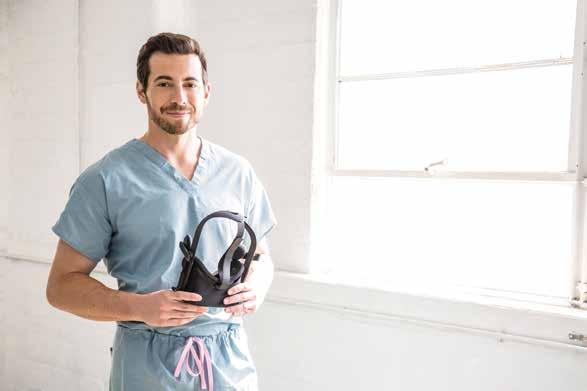
gical training gaps with evidence-based, state-of-the-art immersive technology and a mission to improve outcomes”. In the past year Osso VR secured $66 million in Series C funding to meet demand for state-of-the-art surgical training at scale. The company continued to expand its content library into specialties outside of orthopaedics and demonstrated clinical effectiveness in multiple peer-reviewed journals. Further, Osso VR and the American College of Cardiology announced a new collaboration to develop training for cardiovascular professionals.
Mental health: VR is also being used to treat a variety of mental health conditions, such as anxiety and PTSD. The company Limbix <www.limbix.com> has developed a VR platform that provides exposure therapy for patients with anxiety disorders, while the company Bravemind <https:// medvr.ict.usc.edu/projects/bravemind.html> has developed a VR system that helps veterans with PTSD overcome trauma.
Rehabilitation: VR is being used to help patients recover from injuries and illnesses by providing immersive rehabilitation exercises. The company MindMaze <https://mindmaze.com> has developed a
VR system that helps stroke patients recover movement and function in their limbs.
34 IMIDDLE EAST HEALTH
Virtual reality technology developed by US MedTech company Osso VR is being used for surgical training,
Justin Barad, MD, CEO and co-founder of Osso VR

Becton Dickinson
Target-Controlled Infusion anaesthesia: New more universal models
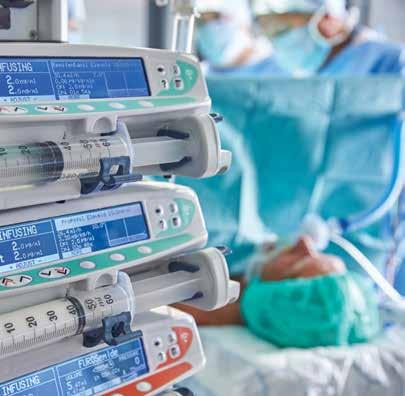 By James Waterson, RN, M.Med.Ed. MHE. Becton Dickinson. Medical Affairs Manager, Middle East & Africa
By James Waterson, RN, M.Med.Ed. MHE. Becton Dickinson. Medical Affairs Manager, Middle East & Africa
In simple terms Target-Controlled Infusion (TCI) means that instead of setting a dose-rate on the pump, the pump is programmed to target a required plasma concentration or effect-site concentration. A TCI pump automatically calculates how much drug is needed during induction and maintenance to maintain the desired effect-site or plasma concentration.
A TCI algorithm (the ‘target’ and plan on which the pump relies to deliver appropriate induction and maintenance rates to maintain anaesthesia without overdosing the patient) is based on pharmacokinetic (PK) and pharmodynamic (PD) models and on Absorption, Distribution, Metabolism, and Excretion of medications by the body.
For example, the effect-site concentration of Propofol required to produce loss of consciousness is about 3 to 6 mcg/ml, depending on the patients’ demographics. Patients waking from anaesthesia generally have a blood concentration of around 1- 2 mcg/ml, although this is dependent on other drugs given during anaesthesia.
Adequate analgesia with Remifentanil is generally achieved with 3-6 ng/ml. A Remifentanil infusion of 0.25-0.5 mcg/kg/ min in an ‘average’ man – 70 kg, 170 cm, 40 years old – produces a blood concentration of around 6ng/ml after 25 minutes.
PK models are based on body compartments
Conventionally the body compart-
ment that the drug is injected into is V1 (plasma/blood), the next compartment is the ‘vessel-rich’ or ‘fast re-distribution’ compartment and is characterized as V2 (heart, liver, etc.). The final compartment, which is anatomically ‘vessel-poor’ and ‘slow’ in terms of re-distribution, is V3 (fatty tissue).
Drug distribution and the metabolism/ elimination of each drug in each compartment is also part of each TCI model, as is the pharmacodynamics of the time taken between the plasma and effect-site effect.
Computer simulations and mathematical modelling of infusion schemes based on the above theories of compartments and clearances give models for both Target Plasma Concentration (Cpt) and Target Effect Concentration (Cet) and these can be incorporated into specialist infusion pumps.
The Marsh model for Propofol requires only age and weight to be programmed in the pump. The Schnider model is an alternative model for Propofol and has advantages in elderly patients as it is based on a lean body mass (LBM) calculation for each patient. Elderly patients receive a lower induction and maintenance dose, which can assist with hemodynamic stability.
The Remifentanil Minto model uses age, height, gender and weight, and determines LBM for its calculations.
TCI pumps deliver the infusion at a constantly altering rate, but it is useful to think of this one infusion as being a meanaverage of three continually calculated infusion rates: a constant rate to replace drug elimination and two exponentially de-
creasing infusions to match drug removed from central compartments to other peripheral compartments of distribution.
Key features of an ideal TCI infusion system or pump are:
• Critical information such as decrement time, current Cet or Cpt and respective targets, current dose rate and concentration and type of agent being infused can be displayed at the same time on one screen.
• Patient parameters used during the setting-up of infusions appear on one screen to avoid the need for shuttling through multiple screens to check vital information.
• An Induction Time adjustable from seconds to minutes to allow for a gentle induction for patients with cardiovascular conditions or established hypotension.
Obese patients have previously presented a problem for ‘classic’ TCI, and the physiological differences between paediatrics and adults had required separate models for children.
Now, however, we have the Eleveld model for both Propofol and Remifentanil, and the Kim-Obara-Egan Remifentanil model which are much more universal and can potentially allow TCI in age ranges from 6 months to 99 years of age, and from 2.5 to 215 kg.
TCI, with its emphasis on evidencebased anaesthesia, and new near-universal patient models seems primed to change our approach to the management of all patients receiving sedatives and analgesic agents.
36 IMIDDLE EAST HEALTH

Surgery
Team performs first-of-its-kind, in-utero procedure to fix deadly vascular malformation
In a first, a team from Brigham and Women’s Hospital and Boston Children’s Hospital successfully treated an aggressive vascular malformation in an infant’s brain before birth, avoiding potentially fatal symptoms after delivery
Collaborating researchers and clinicians from Boston Children’s Hospital and Brigham and Women’s Hospital have prevented a deadly developmental condition by treating an aggressive vascular malformation in an infant’s brain before birth. The case, which is the first-ever, in-utero cerebrovascular surgery in the United States, is described in a paper published in Stroke [1]
As part of an ongoing clinical trial to treat vein of Galen malformation (VOGM) in utero, Boston Children’s Hospital partnered with Brigham and Women’s Hospital Fetal Therapy Program to perform the procedure in an obstetric operating room, with a maternal-foetal medicine specialist and foetal radiologist.
“In every foetal surgery, there are two patients: the baby and the mother, and caring for both the foetus and the mother is an important aspect of foetal procedures,” said coauthor Carol Benson, MD, staff radiologist at BWH and former co-director of BWH’s High-Risk Obstetrical Ultrasound Service. “You need to make sure that everything is aligned perfectly, and we couldn’t do anything without the precise communication and teamwork of everyone involved.”
“In our trial, we are using ultrasound-guided transuterine embolization to address the vein of Galen malformation before birth, and in our first treated case, we were thrilled to see that the aggressive decline usually seen after birth simply did not appear. We are pleased to report that at six weeks, the infant is progressing remarkably well, on no medication, eating normally, gaining weight, and is back home. There are no signs of any negative effects on the brain,” said lead study author Darren B. Orbach, M.D., Ph.D., Co-Director of the Cerebrovascular Surgery & Interventions Center at Boston Children’s Hospital and an
associate professor of radiology at Harvard Medical School. “While this is only our first treated patient and it is vital that we continue the trial to assess the safety and efficacy in other patients, this approach has the potential to mark a paradigm shift in managing vein of Galen malformation, where we repair the malformation prior to birth and head off the heart failure before it occurs rather than trying to reverse it after birth. This may markedly reduce the risk of long-term brain damage, disability, or death among these infants.”
A team that included clinicians from radiology, neurointerventional radiology, anaesthesiology and maternal foetal care performed the in-utero embolization on a foetus with vein of Galen malformation (VOGM) at 34 weeks and 2 days gestational age. The procedure was performed as part of a clinical trial performed with oversight from the U.S. Food and Drug Administration.
VOGM is a rare condition that occurs when misshapen arteries in the brain connect directly to veins instead of capillaries. This slows blood flow and can lead to highpressure blood flowing into the veins. This increase in pressure can prevent an infant’s brain from draining adequately and lead to widespread brain injury or severe loss of tissue in the brain. The standard of care is currently to treat infants with VOGM after they are born, but in many cases, brain damage has already occurred.
“Despite decades of refining the embolization-after-birth technique and the establishment of expert specialty referral centres around the world, foetuses that are
Reference:
diagnosed with vein of Galen malformation continue to have high mortality and high rates of severe neurological impairment,” said Orbach. “Correcting the malformation before birth may prevent brain injury and the often-rapid decline seen after birth and may lead to better outcomes overall for these infants.”
Because of the abnormally high blood flow in the malformation, children born with VOGM do not live long enough to have it diagnosed, with many of them dying within the first few days from heart failure. In this case, after in-utero treatment, the newborn did not require additional surgery after birth and brain MRI showed no strokes, fluid buildup, or haemorrhage often seen with VOGM. The baby, who was born in mid-March, was discharged after several weeks in the NICU and is hitting all of her milestones.
1. Orbach D et al. “Transuterine ultrasound-guided foetal embolization of vein of Galen malformation, eliminating postnatal pathophysiology” Stroke. doi: https://doi.org/10.1136/jnis-2022-019658
38 IMIDDLE EAST HEALTH
This approach has the potential to mark a paradigm shift in managing vein of Galen malformation, where we repair the malformation prior to birth and head off the heart failure before it occurs rather than trying to reverse it after birth.
Future trends in interdisciplinary neurointervention and skull base surgery

Pioneering neurosurgeons revolutionized skull base surgery in the 1980s and 1990s. They invented innovative and safer ways to expose the skull base, remove tumours or treat complex aneurysms and vascular lesions and better ways to reconstruct the skull base to minimize cerebrospinal fluid leaks and infection.
The use of endoscopic surgery, improvements in neuroimaging, radiosurgery or high-energy focused radiotherapy, the perfecting of vascular bypass to treat complex neurovascular conditions, and the use of combined skull base approaches have all changed the way complex skull base pathology is treated today.
Dr Florian Roser, Institute Chair, Neurological Institute and neurosurgeon at Cleveland Clinic Abu Dhabi says: “Interventional neuroradiology developed into a minimally invasive treatment for intracranial diseases, or disorders of the brain or spinal cord. It was most commonly used for diagnosis of intracranial diseases or problems involving blood vessels in the brain or spinal cord, such as aneurysms, arteriovenous malformations and dural arteriovenous fistulae. Interventional neuroradiology has since evolved to become an innovation focus for treatment of these conditions. Disorders that were untreatable just five years ago can now be addressed thanks to advancements in imaging and implant technologies as well as next-level procedural expertise.”
Some of these disorders that are now treatable with neuro-interventional techniques includes embolizing arterio-venous malformations or reconstruction of vessels with in-vessel stents or web-devices
for complex intracranial aneurysm.
With Cleveland Clinic Abu Dhabi’s world-class services and clinical expertise and technology, its interdisciplinary neurointerventional services that offer diagnostic and inter ventional treatments, have seen an in flux of complex cases. Conditions which required open brain surgery in the past can now be treated through an interdisci plinary catheter-based intervention that presents lower risks and chances of quick er discharge from hospital, sometimes on the same day.
Dr Roser continues: “Skull base sur geries can be a routine procedure with high success rates. However, every case is unique and presents its own challenges. To ensure our patients receive a higher chance of a successful outcome, we employ advanced technologies and enhanced operational techniques, such as the use of artificial intelligence, to significantly improve and advance patient outcomes for these complex conditions.
“A.I. can improve diagnostic accuracy and therefore reduce neurosurgical errors. It has the potential to improve postoperative care by providing prognostic information, identifying the presence of problems, and tracking relevant data to aid in patient recovery. Cleveland Clinic Abu Dhabi has already introduced the most advanced stroke interventional system in the UAE, the ARTIS Icono. Using 2D and 3D imaging and incorporating A.I., the ARTIS Icono gives the best image quality and reconstruction in real time. This means that surgeons can skip a CT scan and start treatment right away, saving valuable time.”
Cleveland Clinic Abu Dhabi, a Mubadala Health partner, along with Cleveland Clinic, hosted a major global event in March this year, the 2nd International Neuroscience Summit (INS), that aimed to highlight some of the best practices and future trends in the field of interdisciplinary interventional neuroradiology and skull base surgery. The summit discussed some of the most complex conditions mentioned in the field of neurovascular and skull base surgery and identified ways for minimally invasive interdisciplinary treatment for patients dealing with those conditions. It brought together global leading experts in the field to discuss challenges, risks and even complications with the new techniques in order to find consensus in what paths to follow or to avoid, what tools or implants to use and when to indicate treatment from the various options.
MIDDLE EAST HEALTHI 39
Dr Florian Roser, Institute Chair, Neurological Institute and neurosurgeon at Cleveland Clinic Abu Dhabi
Why safer blood collection products and value-based care go hand in hand

In the last decade, regional and global health organizations have pushed for making safety a central pillar of procurement, with a directive that cost should not be a barrier. The crucial question is: How easy is that to implement? How can a confident decision be reached that protects patients and healthcare workers without straining costs?
Prevention is less expensive than treatment and recovery
A Royal College of Nursing project reported that 100,000 needlestick accidents occur in the UK every year, and Bevan Brittan, a legal firm representing the NHS, estimates the cost of needlestick injuries to each UK NHS trust to be around £500,000 each year in legal costs [1]. And in the US, the initial treatment of a needlestick injury (NSI) can cost between US$800 - $6000 each [2], with initial costs of medication for the Hepatitis C virus starting at around $25,000 [3], and fines from OSHA beginning at $13,260 [4] It should be noted that this is before associated costs are taken into consideration; staff absence interrupts the efficiency of already heavily burdened departments, and reputational damage and morale pose a considerable challenge to a sector that is struggling with staff retention.
The takeaway is that indirect costs exceed the direct costs. The EU and OSHA are rigorous in their safety directives with regards to NSI, and arriving at a decision in selecting a safety device that balances costs without sacrificing safety need not be a complicated process.
Which criteria should be used to evaluate a safety device?
An established culture of safety feeds into the selection process. But with a vast inventory of products available, how can this process be simplified? The decision should be based on the three pillars frontline healthcare worker input, ease of use and protecting patient safety and comfort [5] .
How
chain
does a reliable supply
support safety?
The culture of safety is in place, a short list of prospective manufacturers has been identified, fulfilling the code of conduct and sustainability criteria and the costs are clear. Should the cheapest option then be chosen? This is where a reliable supply chain can really add value in blood collection.
Logistics have been transformed and optimized due to the pandemic, but still face a host of challenges; the costs of raw materials continue to increase and global events impact the availability and delivery of goods. So how does one manufacturer’s offering compare to a competitor’s?
Go with the safety flow
We know that the small details of blood collection kit matter in the lab, just as much as they do on the ward. It is why every detail of our products and services are designed with that safety approach in mind. From the moment a blood sample is drawn, to the moment it becomes data.
Read the full article and other interesting stories on our Safety Blog https:// www.gbo.com/en-int/safeblood-collection/safety-blog
The right safety product for every situation Greiner Bio-One offers an extensive range of safety products, allowing the most suitable products to be selected for every market and customer.
The VACUETTE QUICKSHIELD Safety Tube Holder is especially suitable for routine blood collection. There is no change to the usual collection technique, and the safety shield is activated one-handed. This product can provide the user with the simplest handling and reliable infection protection.
The VACUETTE EVOPROTECT SAFETY Blood Collection Set is the next stage in blood collection. The semi-automatic click mechanism protects the user from the risk of needlestick injuries and makes the daily task of blood collection easier.
References
1. https://www.supplychain.nhs.uk/ programmes/safer-sharps

2. AOHP, 2014
3. HealthDay, 11/6/18
4. OSHA, 2018
5. https://www.jhsph.edu/research/ centers-and-institutes/johns-hopkinseducation-and-research-center-foroccupational-safety-and-azzhealth/ce/ preventing-occupational-exposure-bloodborne-pathogens-healthcare
40 IMIDDLE EAST HEALTH
Greiner Bio-One

Hospital Design
Future-proofing global healthcare infrastructure

How can we build sustainable and resilient hospitals?

Designer Architects
Healthcare infrastructure globally is under immense pressure due to the growing demand for quality healthcare services. Over
the past few decades, as the population continues to soar, the burden on healthcare systems has begun to pile up. This has impelled healthcare planners and policymakers to future-proof the healthcare infrastructure whilst ensuring sustainability and resilience in the healthcare systems. We have also witnessed rapid urbanisation and the emergence of new construction materials and technologies. While green buildings and energy-efficient technologies promise to reduce the carbon footprint and create a healthier built environment, we are beginning to see the irony of what building so-called ‘sustainable’ infrastructure entails, practically. On the other side of the spectrum, the pandemic brought forth the functional inadequacies of healthcare infrastructure across the globe and imposed an urgency to ramp up and
build high-quality infrastructure swiftly.
Today, as we find ourselves amidst a health and climate crisis, the question arises – to build or not to build?
To make this decision, it is essential to recognise the several challenges faced by the healthcare infrastructure in meeting the demands of the growing population. Some of the key challenges are:
Current state of healthcare infrastructure: The world’s population is projected to reach 9.7 billion by 2050, so existing healthcare infrastructure is incapable of accommodating the growing population.
Many healthcare facilities were built decades ago, and they lack the modern amenities, technologies, and proper infrastructure to house advanced equipment to respond to the demand. The scarcity of im-
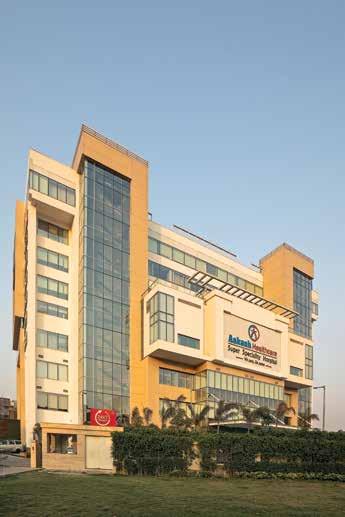
42 IMIDDLE EAST HEALTH
Max Super Speciality Hospital, Vaishali, New Delhi
Akash Super Speciality Hospital, New Delhi

MIDDLE EAST HEALTHI 43
Hospital Design
proved healthcare infrastructure leads to a rise in the cost of healthcare. Healthcare planners need to curate a frugal yet effective model of care delivery as the cost of healthcare is surging acutely.
Stressed doctors and caregivers: Personnel shortages and burn-out is one of the most pressing concerns among healthcare providers. Strategies to promote conducive spaces and strategies that minimise stress and enhance efficiency for caregivers must be adopted while designing healthcare facilities.
Tech-disruption: Careful identification of appropriate technology amidst an exceedingly volatile tech disruption whilst ensuring seamless user experience, ease of operation, high efficiency and data security becomes an important consideration.
Limited resources: Many countries have limited resources to invest in healthcare infrastructure, making it challenging to upgrade facilities to meet the growing demand for healthcare services.
Climate change: Climate change is a global challenge that impacts healthcare infrastructure. Extreme weather events, such as floods and hurricanes, can damage healthcare facilities, disrupt supply chains, and affect the delivery of healthcare services. Planners need to consider these factors to prepare buildings for such emergencies.
Recognising the interconnectedness between the planet and our health, it has become critical for us to explore longterm, sustainable building solutions. As a result, architects are now focused on designing medical facilities that are both sustainable as well as pandemic and future-proof.
Sustainability and healthcare
Lately, adaptively repurposing and reusing existing structures has been a successful endeavour for several industrial and commercial projects, significantly cutting down construction costs and time. Making its way into the healthcare industry, ‘adaptive reuse,’ although deemed a sceptical concept initially, is gradually gaining meaningful acceptance. A hospital’s design specificities often pose a
challenge to effectively repurposing an existing structure for efficiency and safety. However, with careful consideration and meticulous planning, this approach offers financial, environmental, and communal benefits. While an adaptive repurposed hospital can provide high operational efficiency, a few fundamental design decisions can offer adequate resilience and flexibility during times like the COVID-19 pandemic.
Building sustainable and resilient hospitals requires a comprehensive approach that considers the needs of the community, the environment, and the healthcare workforce. A sustainable design for resilient hospitals should be capable of responding to extreme weather events and pandemics. The design must incorporate backup generators, water filtration systems, and ventilation systems to ensure that hospitals remain operational during emergencies. Hospital planners must integrate suitable modern technologies such as artificial intelligence and digitisation of services along with sustainable practices like solar energy provisions, energy efficiency, repurposing of structures, waste reduction and watersaving techniques to reduce operating costs and improve community health.
Pandemic-proof design
Principally, for a hospital to be resilient against any unprecedented adversity, it must focus on three crucial aspects of healthcare planning – triaging, segregating and surging capacity. Triaging and segregation require a carefully planned Emergency Department, which immediately screens and secludes infectious patients within the facility, thus minimising the risk for caregivers and uninfected patients. Segregation refers to the physical separation of spaces and the mechanical isolation of air conditioning systems. This separation could be slightly challenging in areas where the segregated zones do not have separate air handlers – causing return air from the infected zones to recirculate into other hospital areas.
Surging capacity requires additional beds and carefully factoring for the 4 S’s – staff, stuff, structure, and systems. Therefore, resilient healthcare design constitutes facilities that are employed with the requisite
infrastructure and planning with flexibility to escalate their bed numbers while ensuring optimal areas for additional staff and medical paraphernalia. The design impact of such provisions for resilience is based on the factors like ease of expansion for healthcare operators or managers, ensures preparedness in advance which is also cost-efficient and enhances the quality of care even in times of an unprecedented adversity and does not affect the project costs at large, hence is a cost-effective approach to future-proofing hospitals.
Preparing for the future
Most of the healthcare design notions are still based more on experience, intuition, and hypothesis and less on research evidence. The concept of data collection, post-occupancy evaluation and evidencebased design (EBD) is highly concentrated in the West, diminishing its application and efficacy globally. There is hence a need for more local data collection, analysis and research which could help curate high-potency ‘Glocal’ responses.
Future-proofing healthcare infrastructure requires a long-term vision and investment in modern technologies, sustainable practices, and resilient infrastructure. Hospitals should broaden the healthcare horizon beyond buildings to institute a healthier, more resilient population with better endurance against infections, illness, or future pandemics.
Achieving this will involve re-orientating the healthcare system to incorporate the following factors:
1. Investment in workforce development: Healthcare facilities must invest in their workforce to ensure they have the skills and knowledge to deliver quality healthcare services. Workforce development programmes can improve healthcare outcomes and reduce costs by improving the efficiency and effectiveness of healthcare services.
2. Collaborate with communities: Healthcare planners must collaborate with communities to understand their needs and develop impactful solutions. Community engagement can reduce costs by identifying the gaps in the system and enable more thoughtful solutions that address them. During the design and plan-
44 IMIDDLE EAST HEALTH
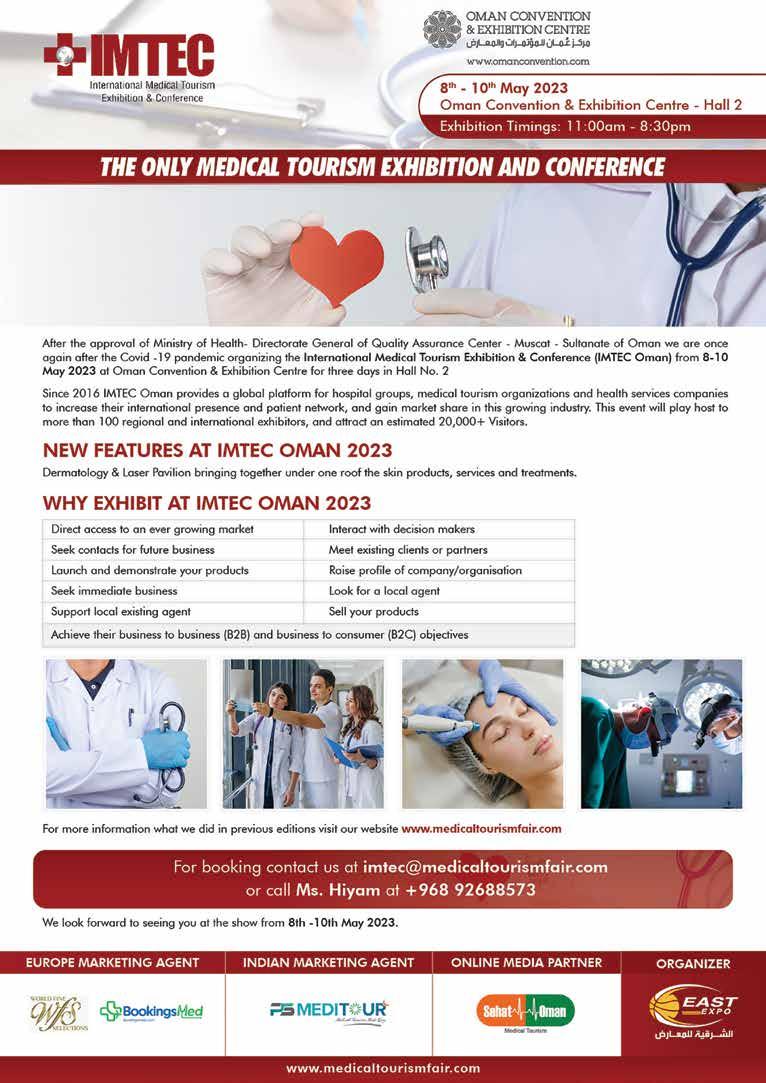
MIDDLE EAST HEALTHI 45
Hospital Design
ning phase of a healthcare ecosystem, designers, developers, policymakers and other stakeholders must consider two fundamental principles – preventive health and wellness and equity in care delivery. Hospitals must focus on community integration and cultural penetration to enhance communal health and wellness. Healthcare providers, policy-makers and designers should come together to design collaborative spaces and programmes that will encourage interaction and educate the community about health and wellness, such as maintaining healthy diets, self-monitoring, etc.
3. Technology integration: Technology has revolutionised healthcare delivery, and we must embrace new technologies to improve the quality and efficiency of healthcare services. Technologies such as telemedicine, artificial intelligence, electronic health records, and IoHT (internet of health things), etc., encourage healthcare to move out of the physical bounds of a hospital building and step into homes through smart technology. The future of healthcare, like most other industries, is digital.
Healthcare futurists and researchers are now focused on orienting the healthcare system towards a physically fragmented and digitally seamless care delivery model. They say the future of healthcare will incorporate IoT, make the best use of rapidly changing technology, and manifest as an
efficient model that is less susceptible to untimely collapse. Employing tools such as Artificial Intelligence will allow healthcare professionals and designers to comprehend patterns emanating from patients’ data and use them to create dynamic, iterative design layouts for reconfigurable hospitals.
Significant strides in research and development of these schemes are underway,
and the future looks promising. The involvement of tech giants is already underway, paving the way for huge investments in research and development in this space.
With a commitment to improving the healthcare scenario, with architects working in partnership with doctors, researchers and tech giants, an evolved healthcare ecosystem awaits us all.

Ravideep Singh is the Associate Director at Creative Designer Architects (CDA), an interdisciplinary architectural practice that is an established design leader in healthcare, institutional and commercial projects.
Ravideep Singh is the Associate Director at Creative Designer Architects, a New Delhi-based architecture firm that has helmed notable projects of diverse typologies across Asia. An alumnus of the University of Illinois Urbana-Champaign, Ravideep has earned a specialisation in ‘Healthcare Planning’ from Cornell University, NY. With a penchant for designing spaces that foster health and wellness, Singh has over six years of experience in healthcare design in India and the United States, working with internationally renowned practices like HDR, HKS, and RSP Architects. At CDA, he has conceptualised several awardwinning projects including AIIMS Guwahati; Nanavati Hospital Mumbai; Aakash Healthcare, New Delhi; Max Super Speciality Hospital, Vaishali; Yashoda Medicity, Ghaziabad; Paras Hospital, Kanpur; Sarvodaya Hospital, Noida; and La Midas Wellness Centre, Gurugram amongst others.
46 IMIDDLE EAST HEALTH
Mayo Institute of Medical Sciences, Lucknow
The author

MIDDLE EAST HEALTHI 47
Evidence of conscious-like activity in the dying brain

Reports of near-death experiences – with tales of white light, visits from departed loved ones, hearing voices, among other attributes – capture our imagination and are deeply engrained in our cultural landscape.
The fact that these reports share so many common elements begs the question of whether there is something fundamentally real underpinning them – and that those who have managed to survive death are providing glimpses of a consciousness that does not completely disappear, even after the heart stops beating.
A new study published in the Proceedings of the National Academy of Science <https:// doi.org/10.1073/pnas.2216268120>, provides early evidence of a surge of activity correlated with consciousness in the dying brain.
The study, led by Jimo Borjigin, Ph.D., associate professor in the Department of Molecular & Integrative Physiology and the Department of Neurology, and her team is a follow-up to animal studies conducted almost ten years ago in collaboration with George Mashour, M.D., Ph.D., the founding director of the Michigan Center for Consciousness Science.
Similar signatures of gamma activation were recorded in the dying brains of both animals and humans upon a loss of oxygen
following cardiac arrest.
“How vivid experience can emerge from a dysfunctional brain during the process of dying is a neuroscientific paradox. Dr Borjigin has led an important study that helps shed light on the underlying neurophysiologic mechanisms,” said Mashour.
The team identified four patients who passed away due to cardiac arrest in the hospital while under EEG monitoring. All four of the patients were comatose and unresponsive. They were ultimately determined to be beyond medical help and, with their families’ permission, removed from life support.
Surge of gamma wave activity
Upon removal of ventilator support, two of the patients showed an increase in heart rate along with a surge of gamma wave activity, considered the fastest brain activity and associated with consciousness.
Furthermore, the activity was detected in the so-called hot zone of neural correlates of consciousness in the brain, the junction between the temporal, parietal and occipital lobes in the back of the brain. This area has been correlated with dreaming, visual hallucinations in epilepsy, and altered states of consciousness in other brain studies.
These two patients had previous reports
of seizures, but no seizures during the hour before their deaths, explained Nusha Mihaylova, M.D., Ph.D., a clinical associate professor in the Department of Neurology who has collaborated with Dr Borjigin since 2015 by collecting EEG data from deceased patients under ICU care. The other two patients did not display the same increase in heartrate upon removal from life support nor did they have increased gamma activity.
Because of the small sample size, the authors caution against making any global statements about the implications of the findings. They also note that it’s impossible to know in this study what the patients experienced because they did not survive.
“We are unable to make correlations of the observed neural signatures of consciousness with a corresponding experience in the same patients in this study. However, the observed findings are definitely exciting and provide a new framework for our understanding of covert consciousness in the dying humans,” she said.
Larger, multi-centre studies including EEG-monitored ICU patients who survive cardiac arrest, could provide much needed data to determine whether or not these bursts in gamma activity are evidence of hidden consciousness even near death.
48 IMIDDLE EAST HEALTH
The Back Page

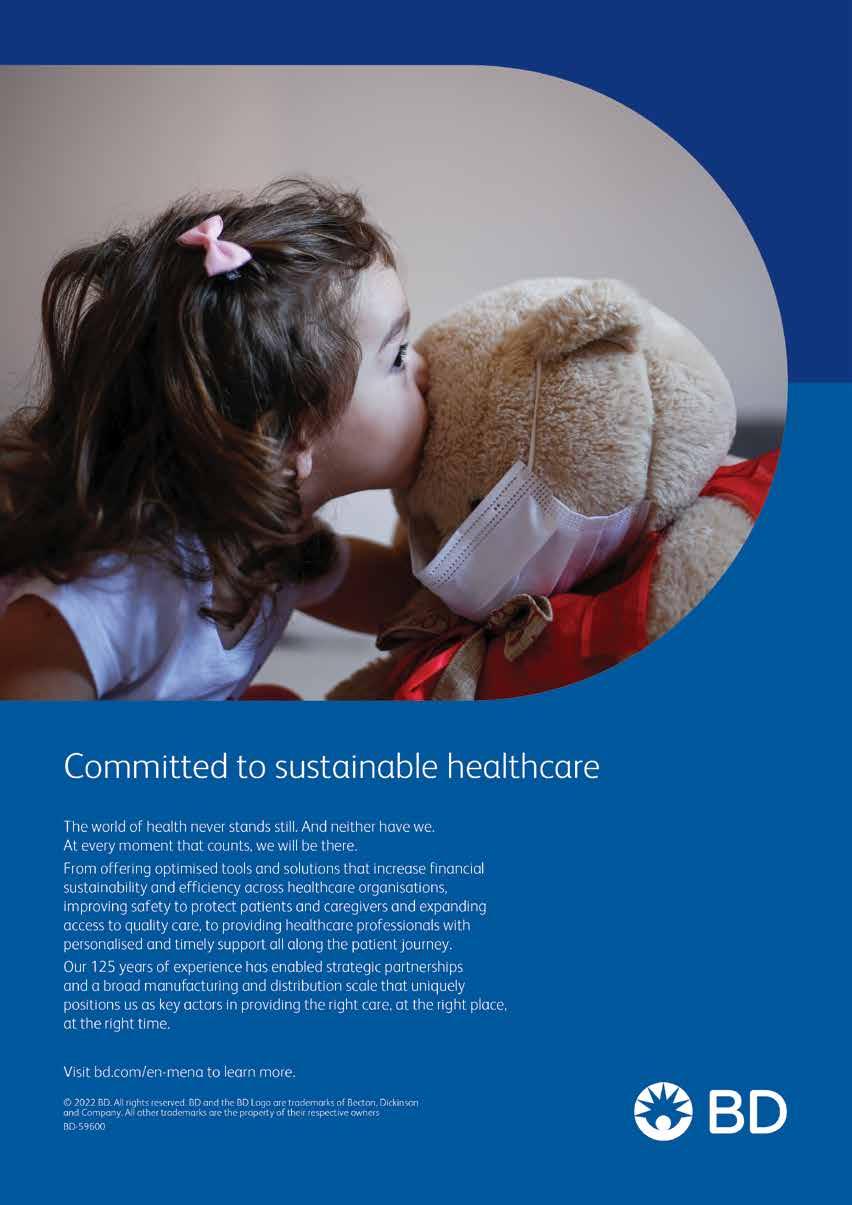





























 Wolters Kluwer
Wolters Kluwer













 By James Waterson, RN, M.Med.Ed. MHE. Becton Dickinson. Medical Affairs Manager, Middle East & Africa
By James Waterson, RN, M.Med.Ed. MHE. Becton Dickinson. Medical Affairs Manager, Middle East & Africa














